Palm trees are some of the most iconic and versatile plants in the world, instantly evoking images of tropical beaches, exotic landscapes, and sunny resorts. But beyond the familiar silhouettes lie an incredible variety of species—each with its own unique characteristics, growth habits, and ideal environments. From towering giants to compact indoor favorites, the many types of palm trees offer something for every garden, climate, and design style.
Understanding the different types of palm trees is essential for anyone looking to grow or identify them. Whether you’re a plant enthusiast, landscaper, or simply curious about the palms you see on vacation, knowing their names, appearances, and growing needs can deepen your appreciation for these fascinating plants. Some palms thrive in arid deserts, while others require lush, tropical settings; some are known for their edible fruits, while others are purely ornamental.
In this guide, we’ll explore 99 types of palm trees, complete with pictures and identification tips. You’ll discover both common and rare varieties, from the popular Coconut Palm to the exotic Tahina Palm. Whether you’re searching for the perfect palm for your backyard or expanding your botanical knowledge, this comprehensive list is your go-to resource.
Common and Popular Palm Trees
Areca Palm (Dypsis lutescens)
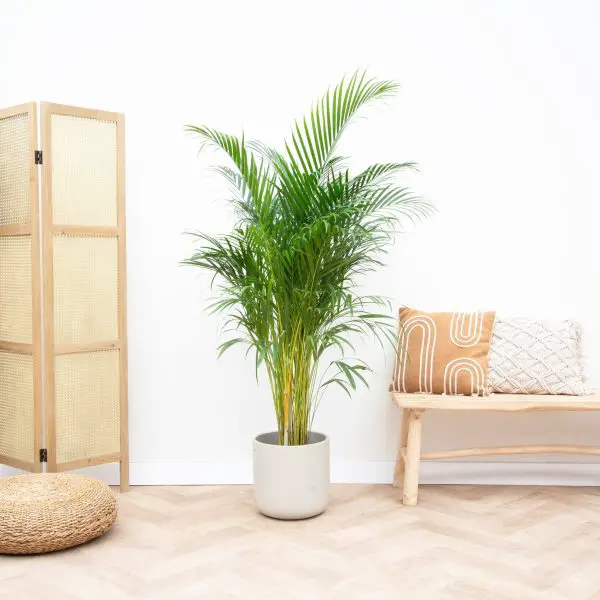
The Areca Palm, also known as the Butterfly Palm, is a popular tropical plant known for its feathery, arching fronds and clustering growth habit. It can grow up to 6 to 10 feet tall indoors and even taller outdoors in tropical settings. The fronds are light green and finely divided, giving the plant a soft, airy appearance, making it a favorite for indoor decoration.
To grow an Areca Palm successfully, it should be planted in well-draining soil and positioned in bright, indirect light. Water the palm consistently but avoid overwatering; the soil should be kept slightly moist but never soggy. Fertilize monthly during the growing season with a balanced liquid fertilizer to support healthy growth.
Areca Palms thrive in USDA hardiness zones 10–11. In cooler regions, they must be grown as houseplants or moved indoors during winter. They prefer temperatures above 55°F (13°C) and do not tolerate frost.
Majesty Palm (Ravenea rivularis)
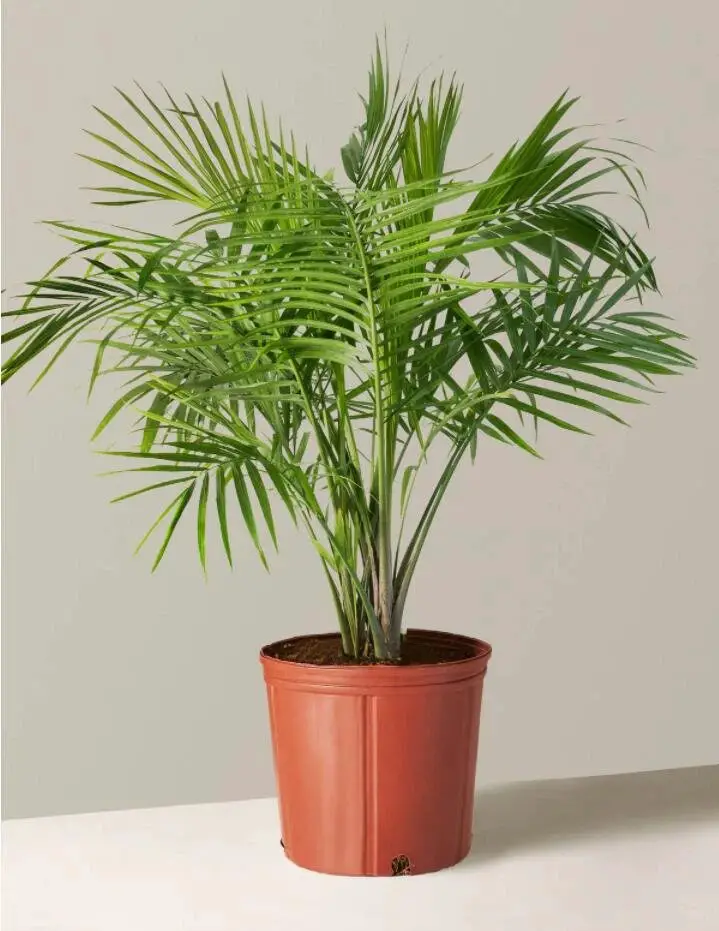
The Majesty Palm is a graceful, elegant palm with long, arching fronds and a straight, slender trunk. It can reach impressive heights outdoors—up to 40 feet—but when grown indoors, it usually stays around 6 to 10 feet tall. Its lush foliage and tropical vibe make it a favorite for interior landscaping.
Majesty Palms require consistently moist soil and high humidity to thrive. They prefer bright, indirect light, though they can tolerate some direct morning sunlight. These palms are sensitive to underwatering and benefit from frequent misting and regular feeding with a palm-specific fertilizer during the growing season.
Best suited for USDA zones 9–11, Majesty Palms can be grown outdoors in warm climates or indoors in containers in cooler areas. They do not tolerate cold drafts or temperatures below 35°F (1.6°C), so indoor placement during winter is essential in temperate regions.
Parlor Palm (Chamaedorea elegans)
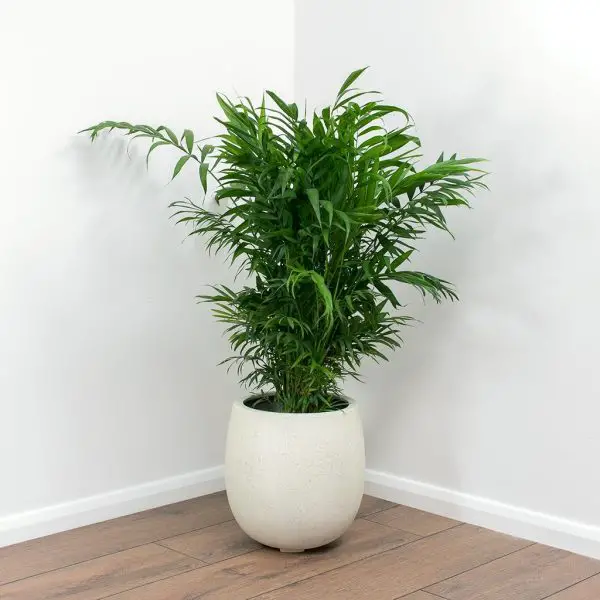
The Parlor Palm is a small, slow-growing palm often chosen for its compact size and ability to thrive in low light conditions. Its delicate, arching fronds emerge from a single slender stem, and mature plants rarely exceed 4 feet tall indoors. This palm has been a popular houseplant since the Victorian era.
It grows well in indirect or filtered light and prefers evenly moist, well-drained soil. Overwatering should be avoided, as it is susceptible to root rot. Fertilize monthly with a diluted houseplant fertilizer during the spring and summer. It also appreciates higher humidity but can adapt to average indoor levels.
Parlor Palms are ideal for growing in USDA zones 10–12 when planted outdoors, although they’re most often kept indoors. They tolerate a wide range of indoor conditions, making them one of the easiest palms for beginners to grow.
Kentia Palm (Howea forsteriana)

The Kentia Palm is a stately and elegant palm that features dark green, feather-like fronds rising from a slender trunk. Native to Lord Howe Island, it is prized for its durability and slow growth, reaching 6 to 12 feet tall indoors over many years. Its graceful fronds make it a top choice for upscale interior decor.
This palm prefers bright, indirect light but can tolerate low-light environments, making it perfect for homes and offices. It should be planted in well-draining potting soil and watered when the top inch of soil feels dry. The Kentia Palm is drought-tolerant once established and should not be overwatered. Fertilize lightly two to three times a year with a palm fertilizer.
Kentia Palms are hardy in USDA zones 9–11, though they’re typically grown as houseplants in cooler climates. They tolerate temperatures down to around 25°F (-4°C) for short periods, making them more cold-tolerant than many tropical palms.
Pygmy Date Palm (Phoenix roebelenii)

The Pygmy Date Palm is a small, slow-growing palm with a graceful crown of arching, fine-textured fronds. It typically grows to about 6–12 feet tall, making it perfect for smaller landscapes or container gardening. The trunk is slender and often appears slightly curved, adding to its ornamental value.
It thrives in full sun to partial shade and prefers moist, well-drained soil. This palm is relatively low-maintenance but benefits from regular watering and a balanced fertilizer applied during the growing season. Trimming dead or damaged fronds helps maintain its attractive appearance.
Best suited for USDA zones 9–11, the Pygmy Date Palm is not frost-hardy and should be protected or brought indoors in cooler climates. When grown indoors, it prefers bright, indirect light and a humid environment to mimic its native tropical conditions.
Sago Palm (Cycas revoluta)
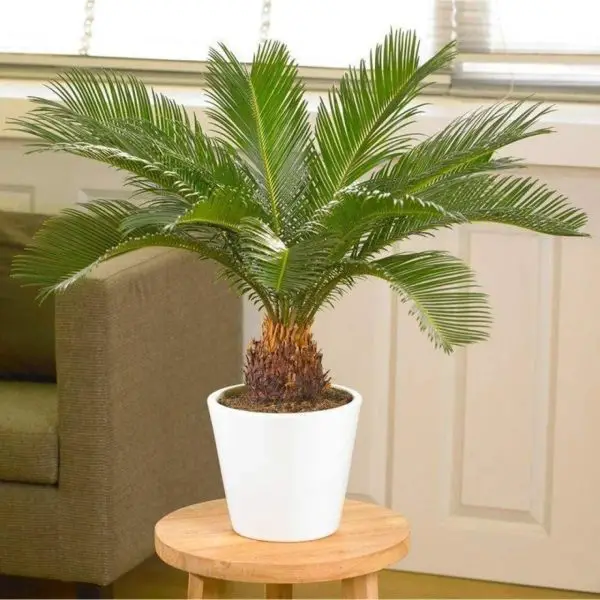
The Sago Palm, despite its name, is a cycad and not a true palm. It has a striking, symmetrical rosette of stiff, dark green leaves that resemble those of palm trees. This ancient plant grows very slowly and can reach 3–10 feet tall over many years. Its bold, architectural shape makes it a standout in both garden beds and containers.
Sago Palms need well-draining soil and do best in full sun to partial shade. Overwatering can lead to root rot, so it’s essential to allow the soil to dry between waterings. These plants are drought-tolerant once established. Use a slow-release fertilizer formulated for palms or cycads, and wear gloves when handling—every part of the plant is toxic to pets and humans.
Sago Palms are hardy in USDA zones 9–11. In colder areas, they should be grown in containers and brought indoors during winter. They prefer temperatures above 50°F (10°C) and can suffer damage in frost conditions.
Ponytail Palm (Beaucarnea recurvata)
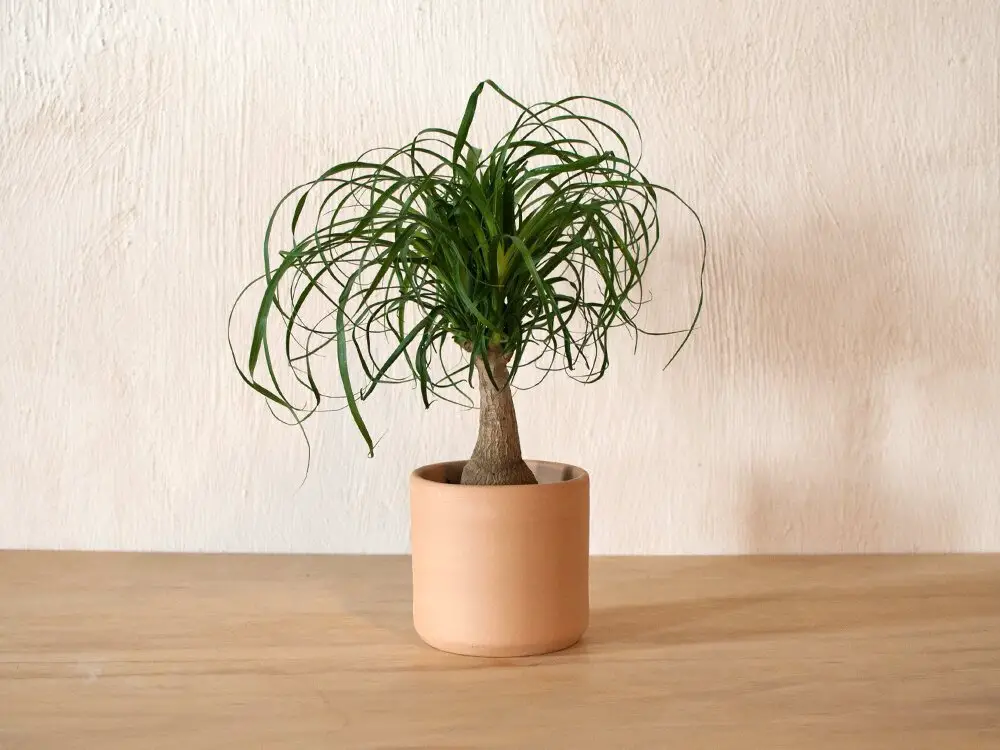
The Ponytail Palm is a striking, drought-tolerant plant with a unique swollen base that stores water and long, curly green leaves cascading like a fountain. Despite its name and palm-like appearance, it is not a true palm but a member of the asparagus family. It typically grows up to 6–10 feet indoors and can reach over 20 feet outdoors in ideal conditions.
This plant thrives in bright light, including direct sun, and prefers well-draining sandy or cactus soil. Allow the soil to dry out completely between waterings. Overwatering is a common issue, so minimal care is usually best. Fertilize with a balanced liquid fertilizer during spring and summer every 4–6 weeks.
Ponytail Palms grow best in USDA zones 9–11. They can be grown indoors anywhere with proper sunlight exposure and are excellent for xeriscaping in warm climates. They tolerate a wide range of temperatures but should be protected from frost.
Coconut Palm (Cocos nucifera)
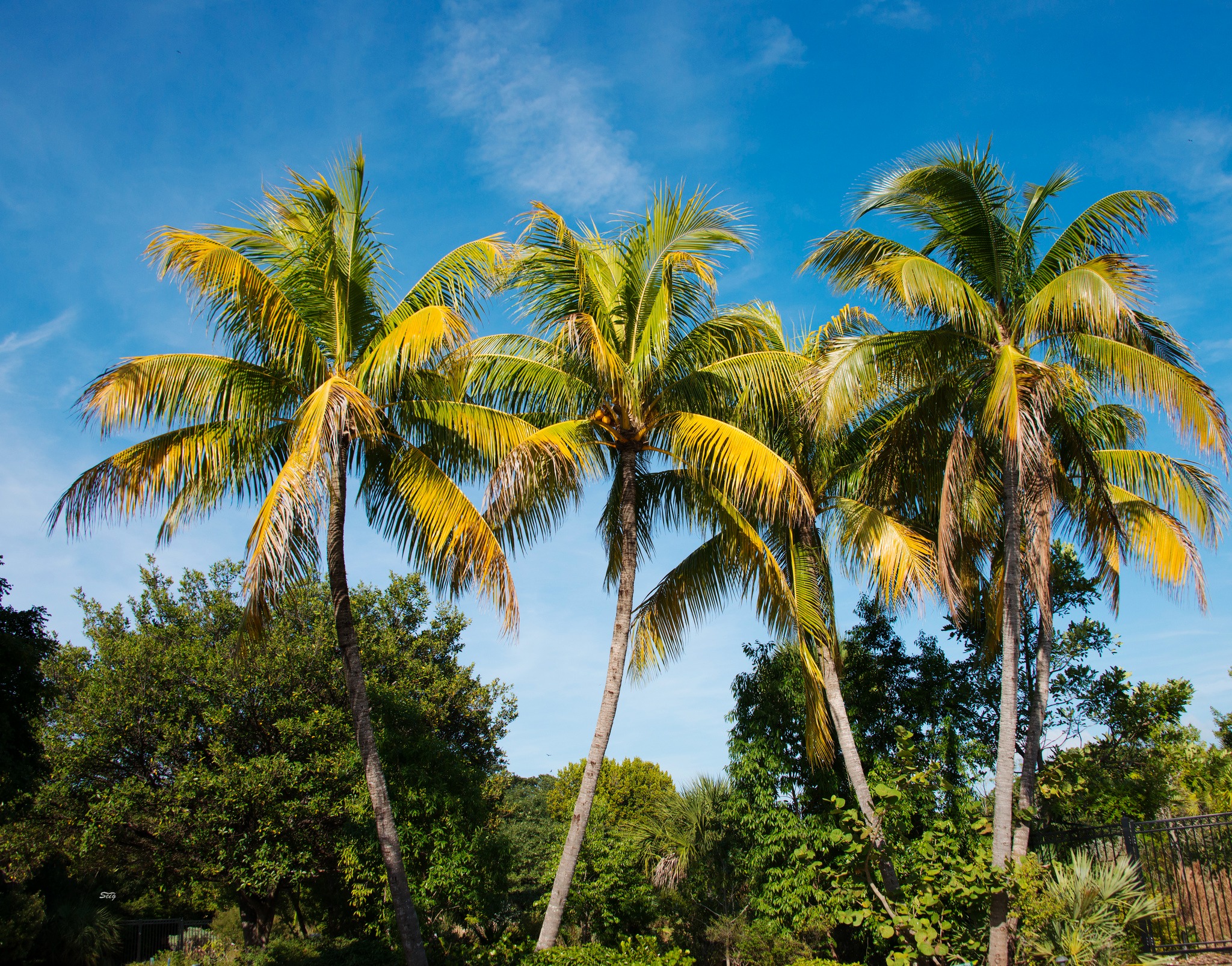
The Coconut Palm is an iconic tropical tree known for its tall, slender trunk and large, arching fronds. It is the tree that produces coconuts, with mature palms reaching up to 60–100 feet in height. Its striking silhouette is a familiar sight on tropical beaches and coastal landscapes.
Coconut Palms need full sun and sandy, well-draining soil to grow well. They require consistent moisture and benefit from regular watering, especially during dry periods. Fertilize with a palm-specific fertilizer rich in potassium and magnesium. These palms are sensitive to cold and thrive only in hot, humid climates.
This palm is suitable for USDA zones 10–12 and grows best in coastal or tropical regions. It cannot tolerate frost or freezing temperatures, making it unsuitable for temperate climates unless grown in protected indoor spaces when young.
Date Palm (Phoenix dactylifera)
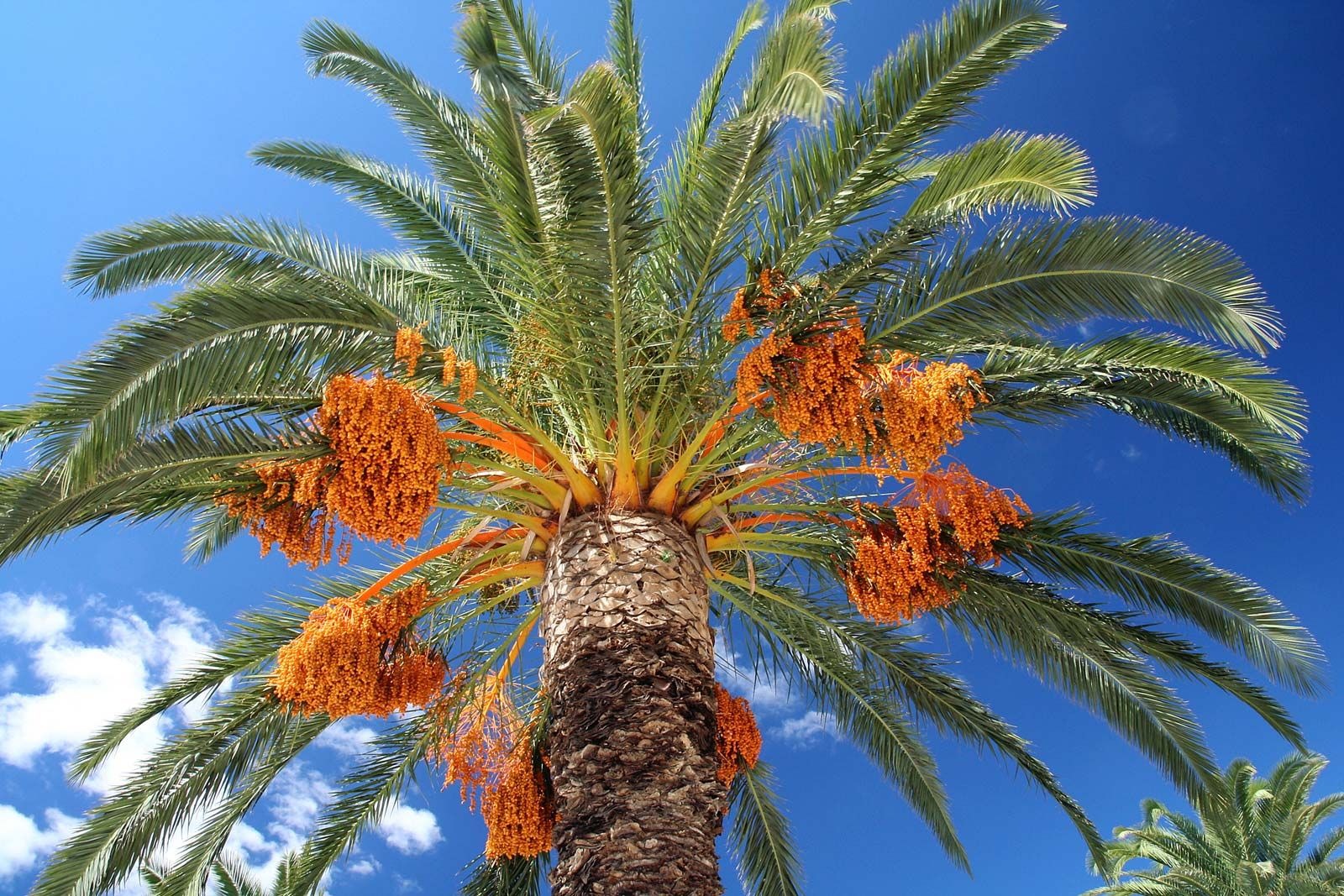
The Date Palm is a stately tree cultivated for thousands of years for its sweet, edible fruits—dates. It features a tall trunk, often marked with diamond-shaped leaf scars, and a crown of feathery, gray-green fronds. Mature trees can reach up to 75 feet tall and have a lifespan of over 100 years.
These palms thrive in full sun and require hot, arid conditions to produce fruit successfully. They prefer sandy, well-drained soil and deep, infrequent watering. Date Palms are tolerant of drought and saline soils. Fertilizing with nitrogen-rich formulations helps promote healthy leaf and fruit production.
Date Palms are best suited to USDA zones 9–11. They grow particularly well in desert regions such as Southern California, Arizona, and parts of the Middle East. Cold temperatures below 20°F (-6°C) can damage or kill young palms.
Queen Palm (Syagrus romanzoffiana)
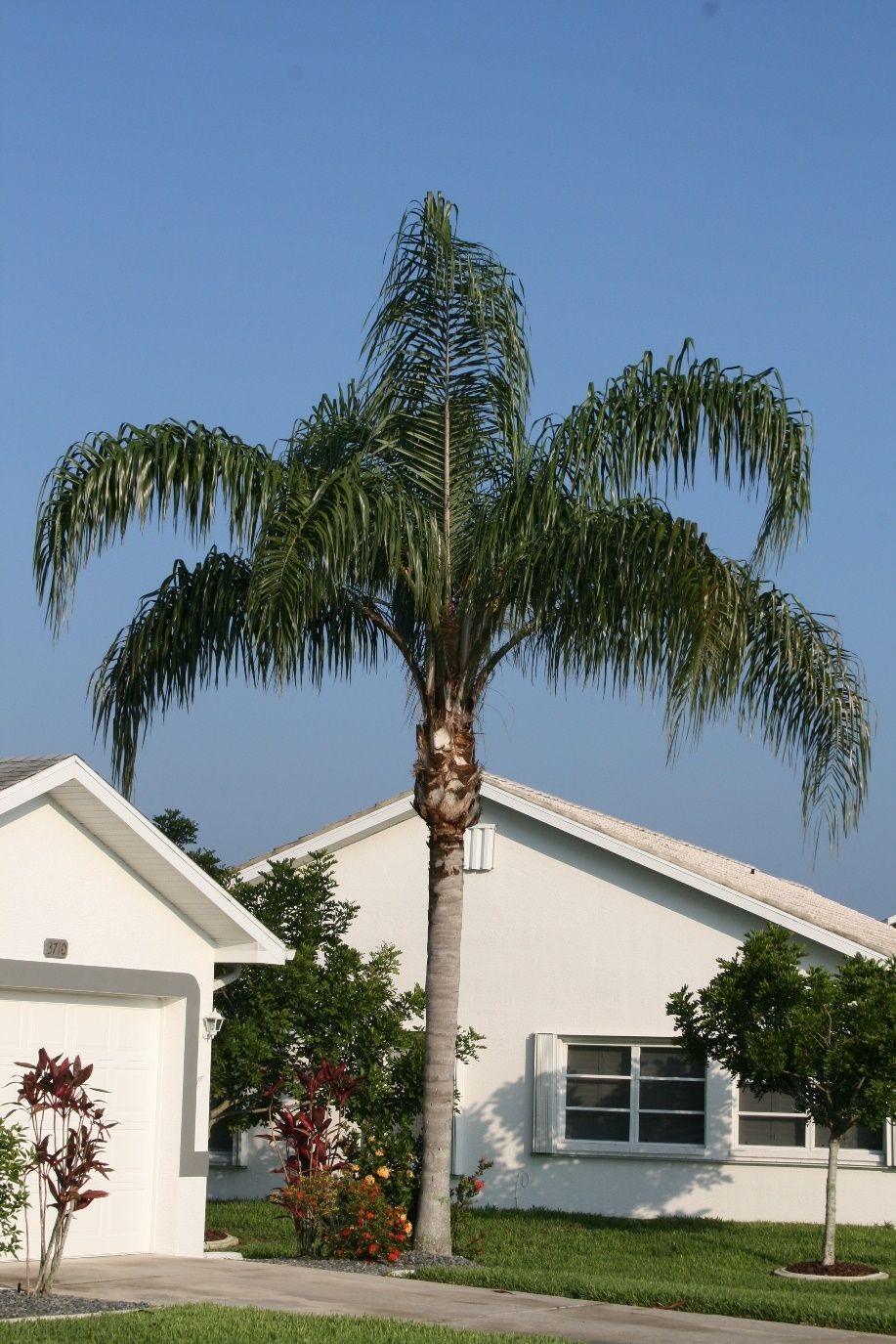
The Queen Palm is a fast-growing and elegant palm known for its smooth, gray trunk and feathery, arching fronds that can span up to 15 feet. It can grow up to 50 feet tall and produces small, orange ornamental fruits that attract birds and other wildlife.
This palm does best in full sun and moist, well-drained soil. Regular watering and fertilizing with a palm-specific product will keep it looking lush and healthy. It prefers slightly acidic soils and should be pruned periodically to remove old fronds and fruit clusters.
Queen Palms are hardy in USDA zones 9–11. They are commonly planted in warm coastal or subtropical regions and are widely used in landscaping for their tropical appearance. While moderately cold-tolerant, they can suffer damage in prolonged frost conditions.
King Palm (Archontophoenix cunninghamiana)
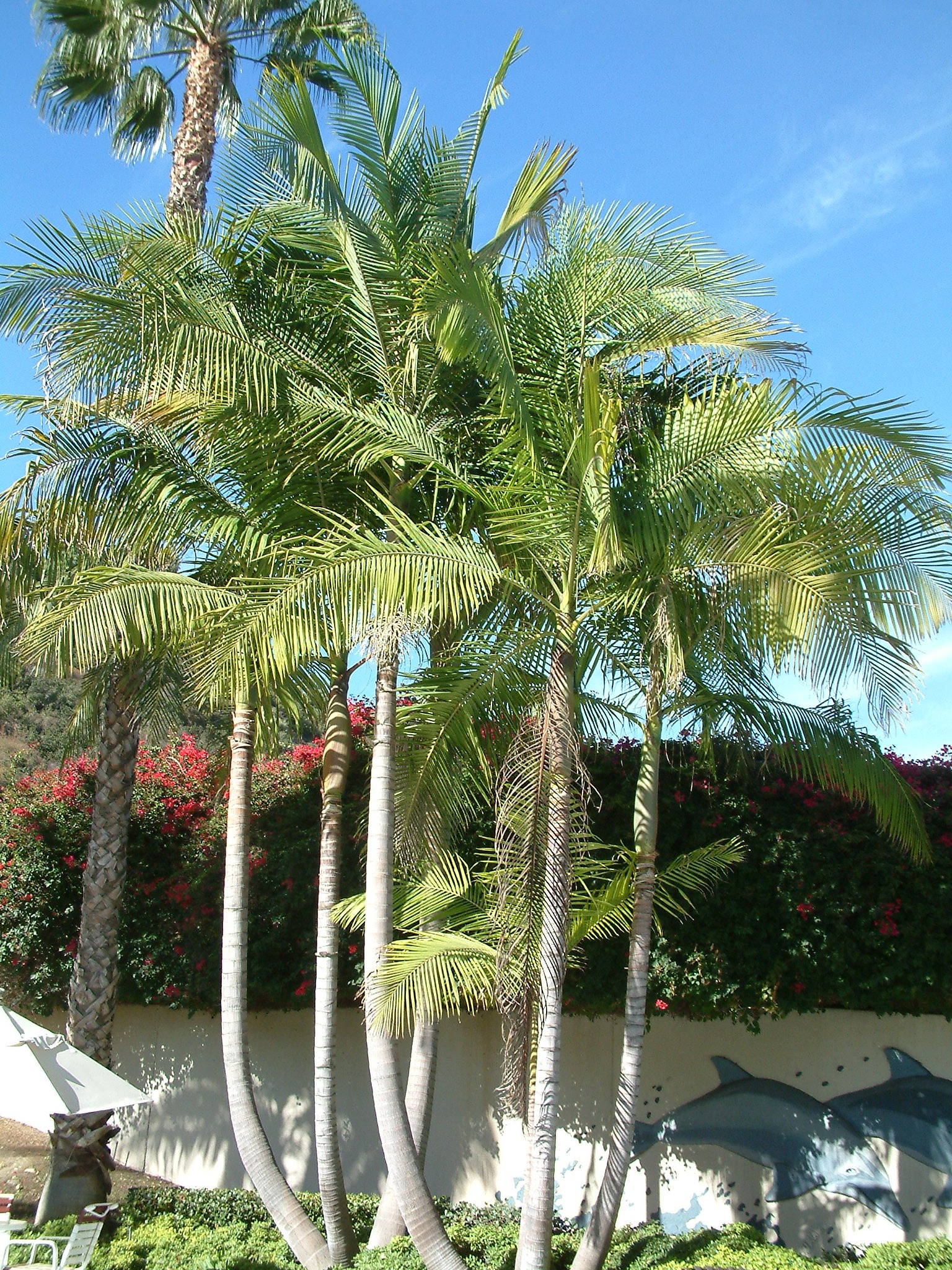
The King Palm is a regal palm tree native to Australia, valued for its upright form and smooth, ringed trunk with a prominent green crownshaft. It features bright green, feathery fronds and can grow up to 40–50 feet in height, making it a stunning feature in gardens and along streets.
It prefers filtered to full sun and consistently moist, well-draining soil. The King Palm appreciates high humidity and regular watering, especially during hot weather. Use a balanced fertilizer for palms during the growing season to support healthy growth and vibrant foliage.
This palm grows best in USDA zones 9b–11 and thrives in mild, frost-free climates such as coastal California. It can tolerate short periods of cold down to 25°F (-4°C) but may be damaged by prolonged freezing temperatures.
Foxtail Palm (Wodyetia bifurcata)
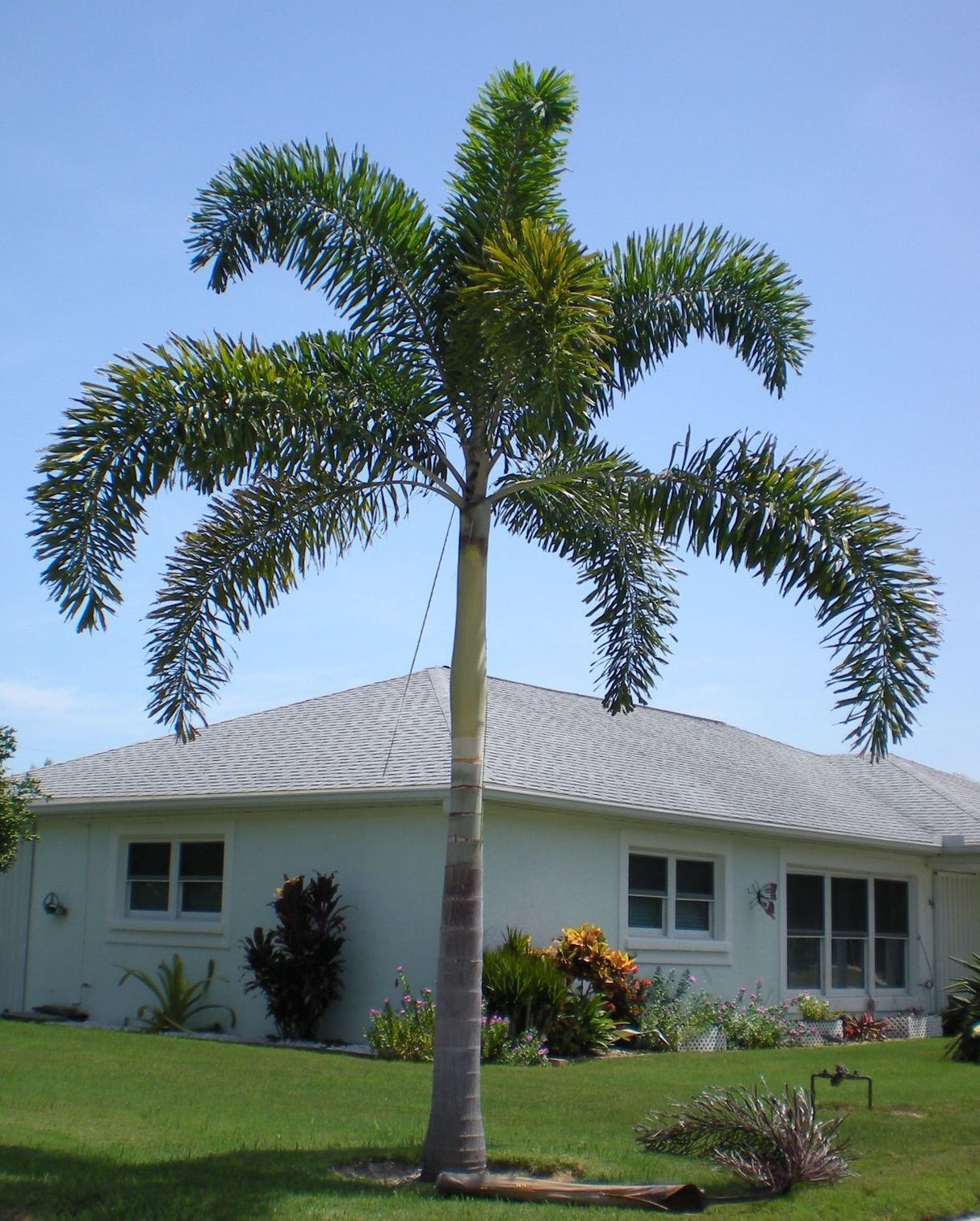
The Foxtail Palm is named for its bushy, plume-like fronds that resemble a fox’s tail. Native to Australia, this palm has a solitary, smooth gray trunk and grows quickly to a mature height of 20–30 feet. Its lush, full canopy and self-cleaning nature make it a favorite in modern tropical landscaping.
This palm prefers full sun but can tolerate partial shade. It grows best in sandy, well-draining soil and requires regular watering, especially during dry periods. Fertilize with a palm blend high in potassium and magnesium to prevent nutrient deficiencies and leaf browning.
Foxtail Palms are suitable for USDA zones 10–11. They thrive in tropical and subtropical climates and are relatively low-maintenance compared to other palms. While somewhat cold-sensitive, mature specimens can tolerate brief dips to around 30°F (-1°C).
Windmill Palm (Trachycarpus fortunei)
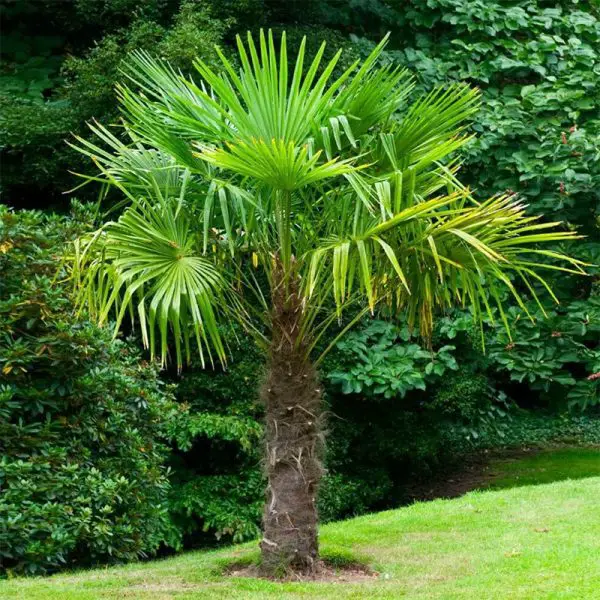
The Windmill Palm is a hardy, slow-growing palm known for its fan-shaped leaves and fibrous, hairy trunk. It typically grows 10 to 40 feet tall and is an excellent choice for cooler climates where most palms cannot survive. The symmetrical crown and compact size make it ideal for small gardens and urban landscaping.
This palm prefers partial shade to full sun and thrives in well-drained, fertile soil. While it’s fairly drought-tolerant once established, regular watering will promote faster growth and lush foliage. Applying a balanced fertilizer in spring and summer encourages healthy development.
Windmill Palms are cold-hardy and can thrive in USDA zones 7–11. They are one of the few palm species that can withstand temperatures as low as 5°F (-15°C), making them a popular option in temperate regions like the Pacific Northwest and the Mid-Atlantic.
Bottle Palm (Hyophorbe lagenicaulis)
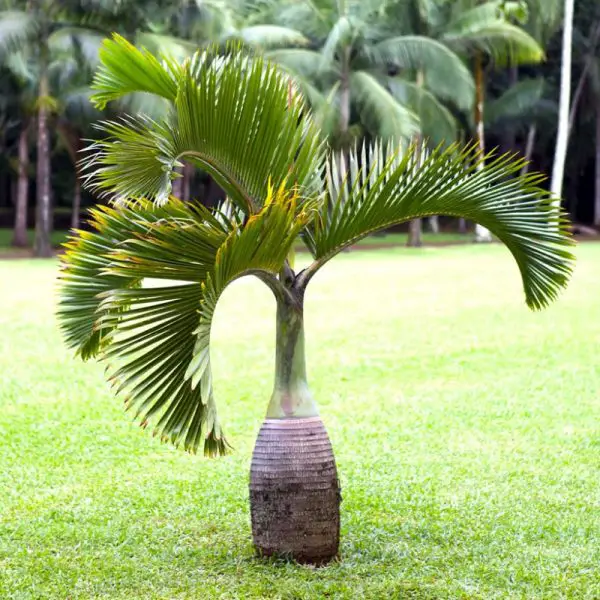
The Bottle Palm is a unique ornamental palm named for its swollen, bottle-shaped trunk that stores water. It features a smooth gray trunk and four to six graceful fronds that create a tropical silhouette. This small palm grows slowly and typically reaches a height of 10–12 feet at maturity.
It prefers full sun and requires a warm, humid environment to thrive. Well-drained soil and consistent moisture are essential, though overwatering should be avoided. The Bottle Palm is sensitive to cold and should be protected from temperatures below 30°F (-1°C). A palm-specific fertilizer applied during the growing season will support healthy fronds.
Bottle Palms grow best in USDA zones 10–11 and are ideal for coastal landscapes or container growing in tropical and subtropical regions. They can be brought indoors or sheltered during cold snaps in borderline climates.
Bismarck Palm (Bismarckia nobilis)
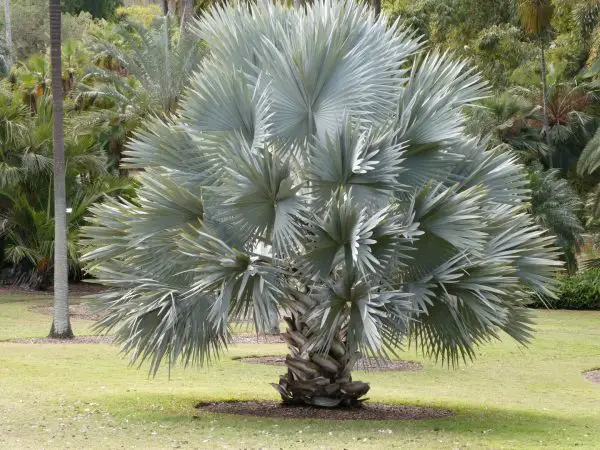
The Bismarck Palm is a majestic species prized for its striking silver-blue, fan-shaped leaves that can span up to 10 feet wide. It has a stout, columnar trunk and can grow up to 30–60 feet tall, making it a bold statement tree in any landscape.
This palm thrives in full sun and requires well-draining soil to prevent root rot. It is highly drought-tolerant once established, though young trees benefit from regular watering. Avoid overwatering and use a slow-release fertilizer formulated for palms to maintain its vivid leaf color.
Bismarck Palms are best suited for USDA zones 9–11. They grow well in warm, dry climates like southern Florida, southern Texas, and parts of California. These palms are not cold-hardy and should be protected if temperatures fall below 25°F (-4°C).
European Fan Palm (Chamaerops humilis)
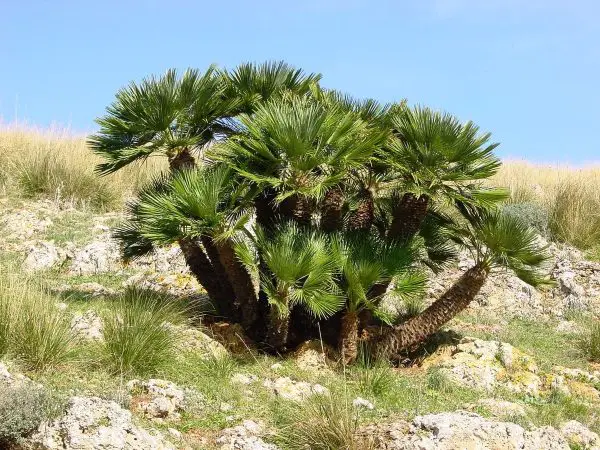
The European Fan Palm is a compact, clumping palm with multiple trunks and dense, fan-shaped leaves in shades of green or blue-green. It typically grows up to 10–15 feet tall and is popular for its cold hardiness and adaptability to various garden styles.
This palm thrives in full sun to partial shade and grows well in a variety of well-drained soils, including sandy and rocky types. It is drought-tolerant and low-maintenance, needing only occasional watering once established. Prune off dead fronds to maintain its shape and appearance.
European Fan Palms are hardy in USDA zones 8–11 and can tolerate cold down to around 10°F (-12°C). Their toughness makes them one of the best palms for Mediterranean gardens and landscapes in the southern and western U.S.
Chinese Fan Palm (Livistona chinensis)
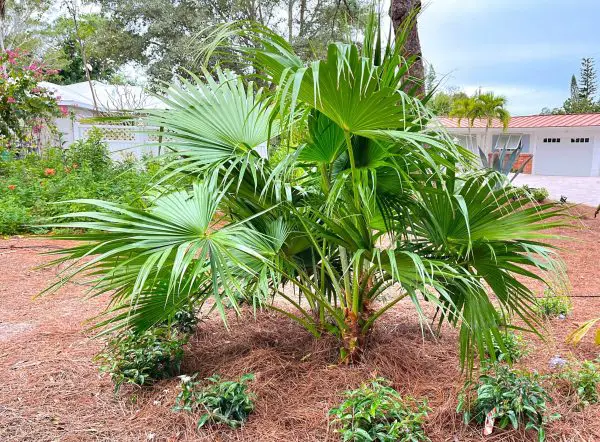
The Chinese Fan Palm, also known as the Fountain Palm, is a graceful palm with large, fan-shaped fronds that droop slightly, resembling a fountain. It can grow up to 30–40 feet tall outdoors but remains smaller in containers or indoor environments.
It prefers full sun to light shade and needs well-drained, fertile soil. Water regularly during the growing season but let the soil dry between waterings. It adapts well to both humid and dry environments and benefits from occasional feeding with a balanced fertilizer.
This palm grows best in USDA zones 9–11. It is moderately cold-hardy and can tolerate temperatures down to 15–20°F (-9 to -6°C). Its versatility and attractive shape make it suitable for both large landscapes and indoor atriums.
Spindle Palm (Hyophorbe verschaffeltii)
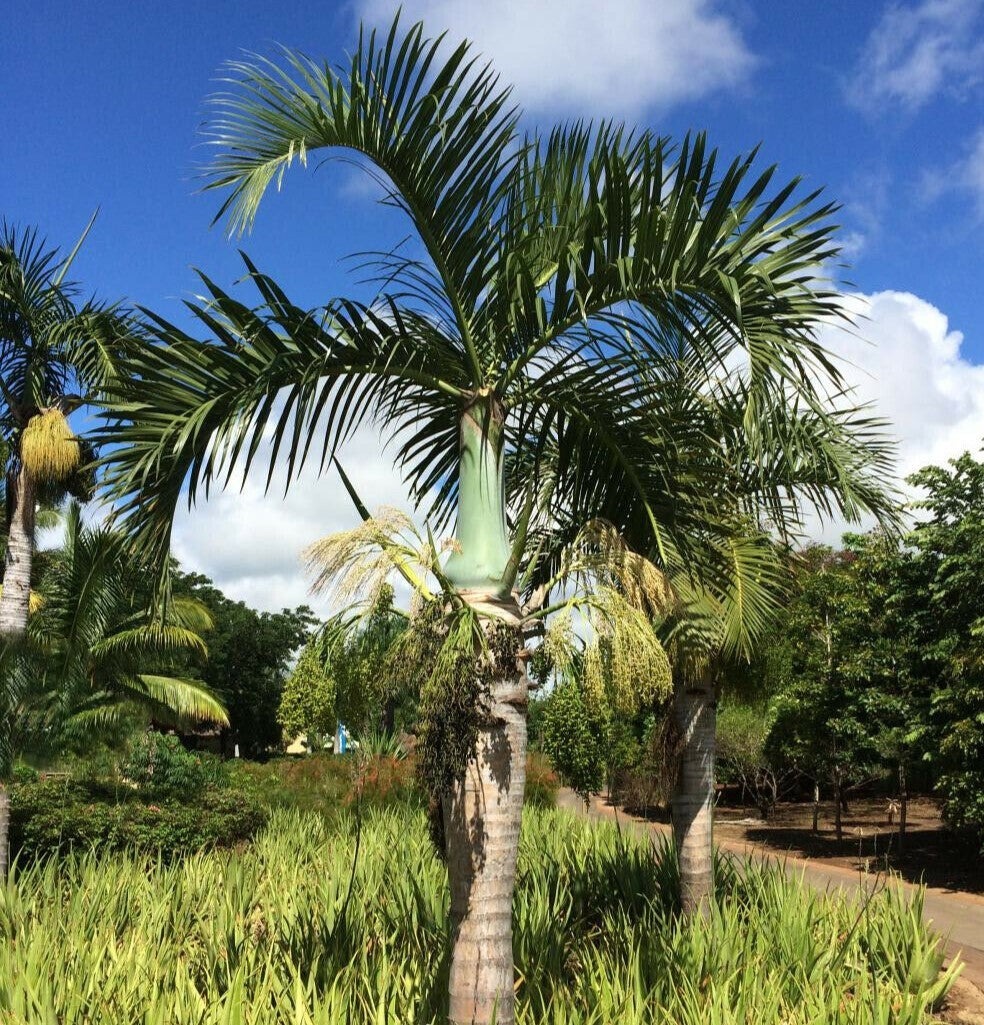
The Spindle Palm gets its name from the distinctive swelling in the middle of its trunk, which resembles a spindle. It grows slowly and usually reaches about 10–20 feet tall. Its smooth gray trunk, bright green crownshaft, and feathery fronds give it a refined, tropical look.
This palm needs full sun and thrives in warm, humid conditions. It prefers sandy, well-drained soil and regular watering, especially during dry spells. Like the Bottle Palm, it is sensitive to cold, so it should be protected or brought indoors in cooler climates. Fertilize in spring and summer with a palm-specific formula.
Spindle Palms are best suited to USDA zones 10–11. They are ideal for tropical gardens, poolside landscapes, or as specimen plants in containers. Avoid planting in areas where temperatures drop below 30°F (-1°C).
Needle Palm (Rhapidophyllum hystrix)
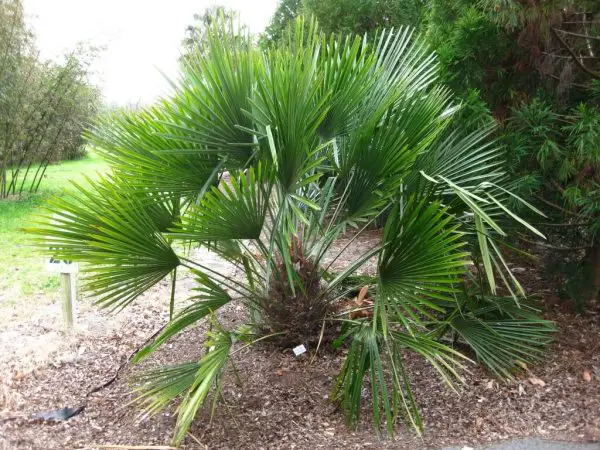
The Needle Palm is one of the most cold-hardy palms in the world, making it a favorite among gardeners in cooler climates. This slow-growing, shrubby palm typically reaches 4 to 6 feet in height and features dark green, fan-shaped fronds radiating from a central crown. Its name comes from the sharp, needle-like spines that grow around the base of the leaf stems, providing natural protection.
It thrives in partial to full shade and prefers moist, well-drained soil rich in organic matter. Although drought-tolerant once established, it performs best with consistent watering. Mulching helps retain soil moisture and protect its roots during colder months. Minimal pruning is needed, as the plant maintains a tidy shape on its own.
Needle Palms grow well in USDA zones 5–10, tolerating temperatures as low as -10°F (-23°C). They’re ideal for woodland gardens, shady spots, or naturalized areas in regions that experience frost and snow, making them a reliable palm choice for the southeastern and mid-Atlantic United States.
Triangle Palm (Dypsis decaryi)

The Triangle Palm is a striking ornamental palm native to Madagascar, known for its unique triangular shape formed by the arrangement of its fronds at 120-degree angles around the trunk. It grows up to 25–30 feet tall and features silvery-green to bluish fronds that arch gracefully, giving it a sculptural, modern appearance.
This palm prefers full sun and well-draining soil with moderate moisture. It is relatively low-maintenance, though young plants benefit from regular watering during dry periods. Triangle Palms dislike being waterlogged, so avoid heavy clay soils or overwatering. A balanced fertilizer applied in spring and summer will encourage steady growth and vibrant foliage.
Triangle Palms thrive in USDA zones 10–11 and are best suited for warm, frost-free areas. They are popular in tropical and subtropical landscapes, especially as focal points or accent trees in contemporary garden designs. In cooler zones, they can be grown in containers and moved indoors during winter.
Tropical and Ornamental Palms
Mexican Fan Palm (Washingtonia robusta)
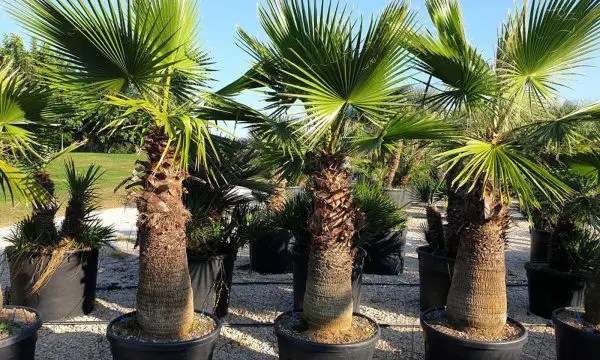
The Mexican Fan Palm is a tall, fast-growing palm known for its slender trunk and large, fan-shaped fronds. It can reach heights of 70 to 100 feet and is commonly seen lining streets and boulevards in warm climates. Its crown consists of bright green, slightly drooping leaves that create a fountain-like appearance.
This palm prefers full sun and thrives in well-drained soil. It is drought-tolerant once established, but regular watering helps support rapid growth in the early stages. While it requires little maintenance, pruning may be needed to remove dead fronds and maintain a tidy look. Fertilize in spring and summer to boost growth.
Mexican Fan Palms grow best in USDA zones 9–11. They are ideal for hot, dry regions like southern California, Arizona, and parts of Texas. However, they are sensitive to hard freezes and should not be planted in areas with prolonged cold temperatures.
California Fan Palm (Washingtonia filifera)
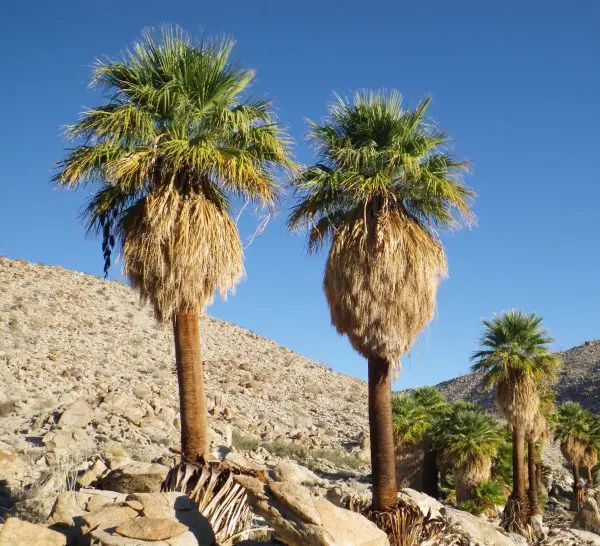
The California Fan Palm, also known as the Desert Fan Palm, is a robust, slow-growing species native to the southwestern United States. It features a thick, gray trunk and large, fan-like fronds that form a full, rounded crown. This palm typically grows 40 to 60 feet tall and often retains a skirt of dried fronds unless pruned.
It prefers full sun and sandy, well-drained soils. While drought-tolerant, it performs best with occasional deep watering, especially during hot summers. Unlike its cousin the Mexican Fan Palm, it is more cold-hardy and better suited to arid desert conditions. Minimal fertilization is required, but feeding once or twice a year can enhance growth.
California Fan Palms are suited for USDA zones 8–11. They are especially popular in desert and Mediterranean climates, making them perfect for landscapes in southern California, Nevada, and Arizona.
Florida Thatch Palm (Thrinax radiata)
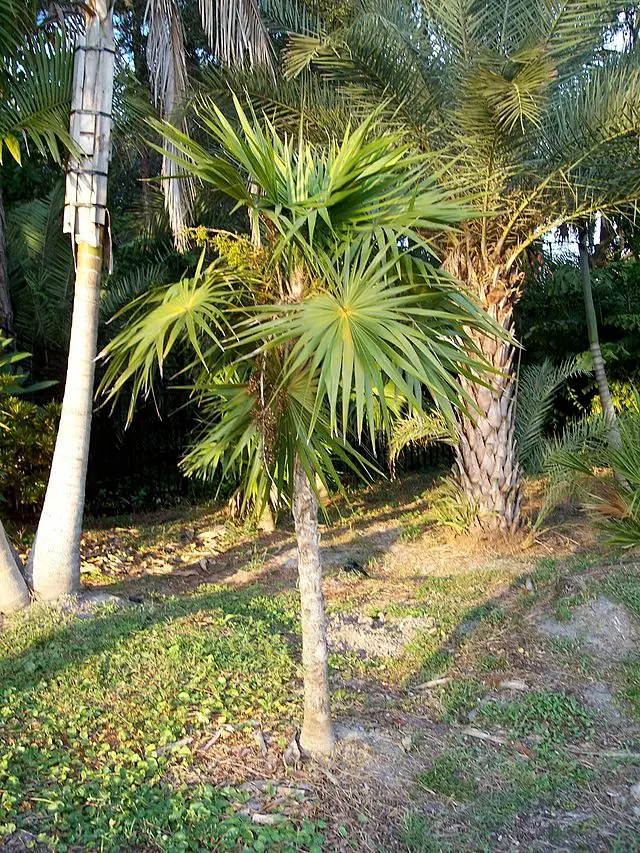
The Florida Thatch Palm is a small, slow-growing palm native to Florida and the Caribbean. It usually reaches a height of 10 to 20 feet and features a slender, solitary trunk topped with a crown of fan-shaped, green fronds. Its refined appearance makes it a great choice for tropical gardens and coastal landscapes.
It thrives in full sun to partial shade and prefers sandy, well-draining soil. This palm is moderately drought-tolerant but will perform best with regular watering and occasional feeding. It is salt-tolerant, making it ideal for seaside planting. Prune dead fronds to keep it looking tidy and neat.
Florida Thatch Palms grow well in USDA zones 10–11. They are most successful in southern Florida and other frost-free, humid areas, where they are often used as specimen trees or accent plants in gardens and resorts.
Cabbage Palm (Sabal palmetto)
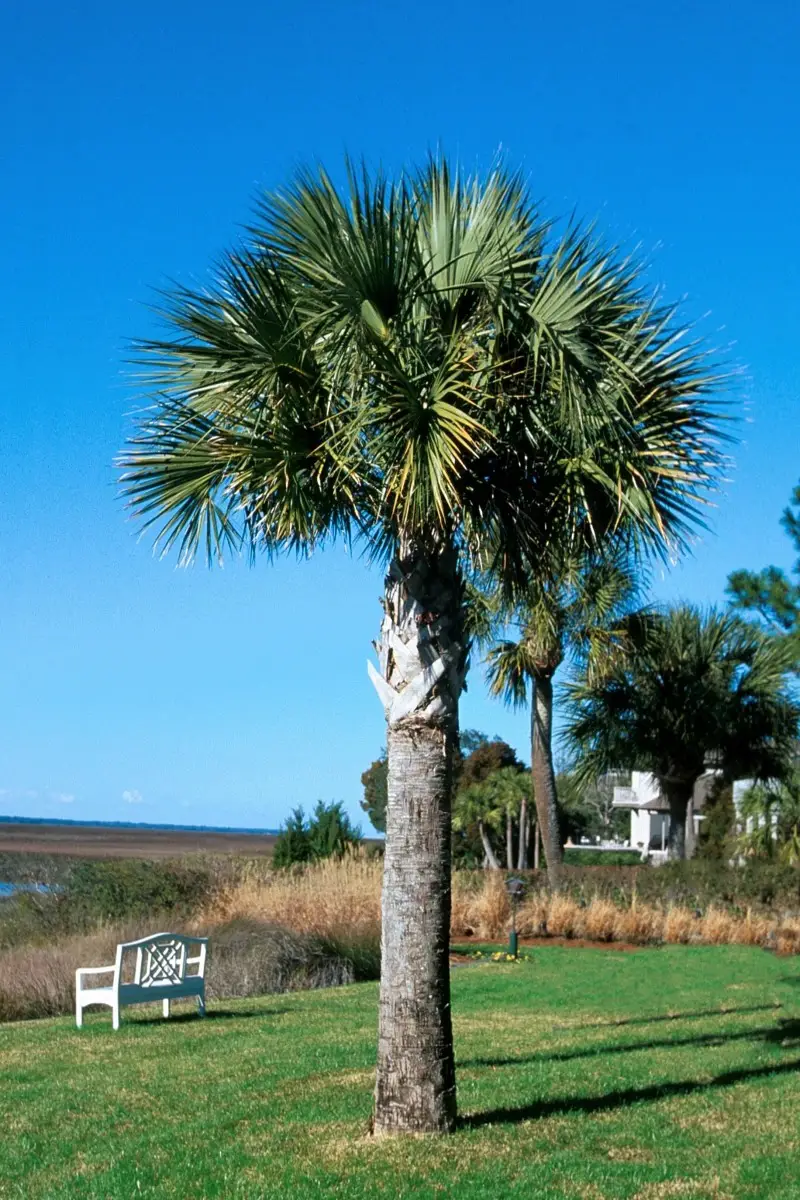
The Cabbage Palm, also called Sabal Palm, is the state tree of Florida and South Carolina and is well-loved for its toughness and versatility. It grows up to 40–60 feet tall and has a stout, unbranched trunk topped with a rounded crown of fan-shaped fronds. Its name comes from the edible “heart” at its center.
This palm adapts well to a variety of soils, including sandy and salty coastal environments. It thrives in full sun but can tolerate partial shade. While relatively drought-tolerant, it benefits from occasional watering and annual fertilization. Once established, it’s virtually maintenance-free and pest-resistant.
Cabbage Palms are cold-hardy and grow in USDA zones 8–11. They’re common throughout the southeastern U.S., especially along the Atlantic and Gulf coasts, where they withstand hurricanes, salt spray, and urban pollution.
Sabal Minor (Sabal minor)
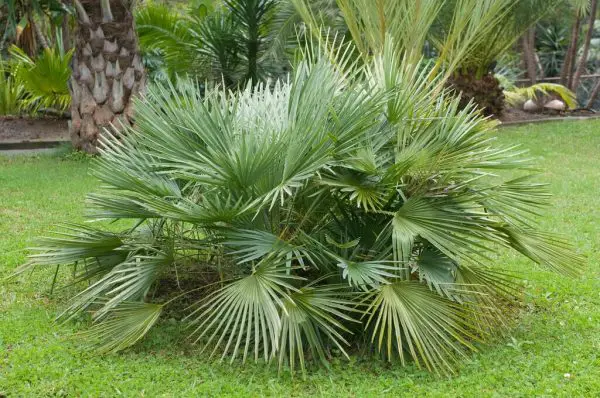
Sabal Minor, or Dwarf Palmetto, is a hardy, shrubby palm that rarely exceeds 6 feet in height. It has fan-shaped leaves that grow from a short trunk, often hidden underground. Its compact form and high cold tolerance make it a favorite for naturalistic and woodland gardens.
This palm thrives in partial shade to full sun and grows in a wide range of soil types, including moist or occasionally wet areas. It requires minimal care once established, needing only occasional watering. It is also resistant to pests, diseases, and cold weather. Fertilize sparingly to maintain healthy growth.
Sabal Minor is extremely cold-hardy and grows in USDA zones 7–11. It is well-suited to the southeastern and south-central United States and is often used in low-maintenance, native, or wetland landscapes.
Saw Palmetto (Serenoa repens)

The Saw Palmetto is a low-growing, clumping palm native to the southeastern U.S., particularly Florida. It features fan-shaped, silver-green to blue-green leaves that emerge from creeping stems, often forming dense thickets. This palm typically reaches 5 to 10 feet tall and is known for its medicinal berries.
It grows well in full sun to partial shade and adapts to a variety of soil types, including sandy or nutrient-poor soils. Saw Palmetto is extremely drought-tolerant and requires little to no maintenance once established. It’s also salt-tolerant and well-suited to coastal areas. Fertilization is optional but can promote fuller growth.
Saw Palmettos thrive in USDA zones 7–11. They are perfect for naturalistic plantings, wildlife gardens, and erosion control. Their hardiness and adaptability make them a top choice for low-water, native landscapes in the southeastern U.S.
Paurotis Palm (Acoelorrhaphe wrightii)

The Paurotis Palm, also known as the Everglades Palm, is a clustering palm native to the wetlands of Florida, Central America, and the Caribbean. It features multiple slender trunks covered in fibrous matting and topped with fan-shaped, light green fronds with silvery undersides. This palm can reach heights of 20 to 30 feet and spreads wide, making it an eye-catching addition to tropical landscapes.
It thrives in full sun to partial shade and prefers moist, well-draining soil. It is highly tolerant of wet conditions and can even grow in periodically flooded areas. Regular watering and occasional feeding help promote healthy growth, though it’s relatively low-maintenance once established. Prune off old fronds to maintain a clean appearance.
Paurotis Palm grows best in USDA zones 9–11. It is well-suited for warm, humid regions such as southern Florida and coastal areas, where it’s often used as a privacy screen or natural hedge due to its dense growth.
Lipstick Palm (Cyrtostachys renda)
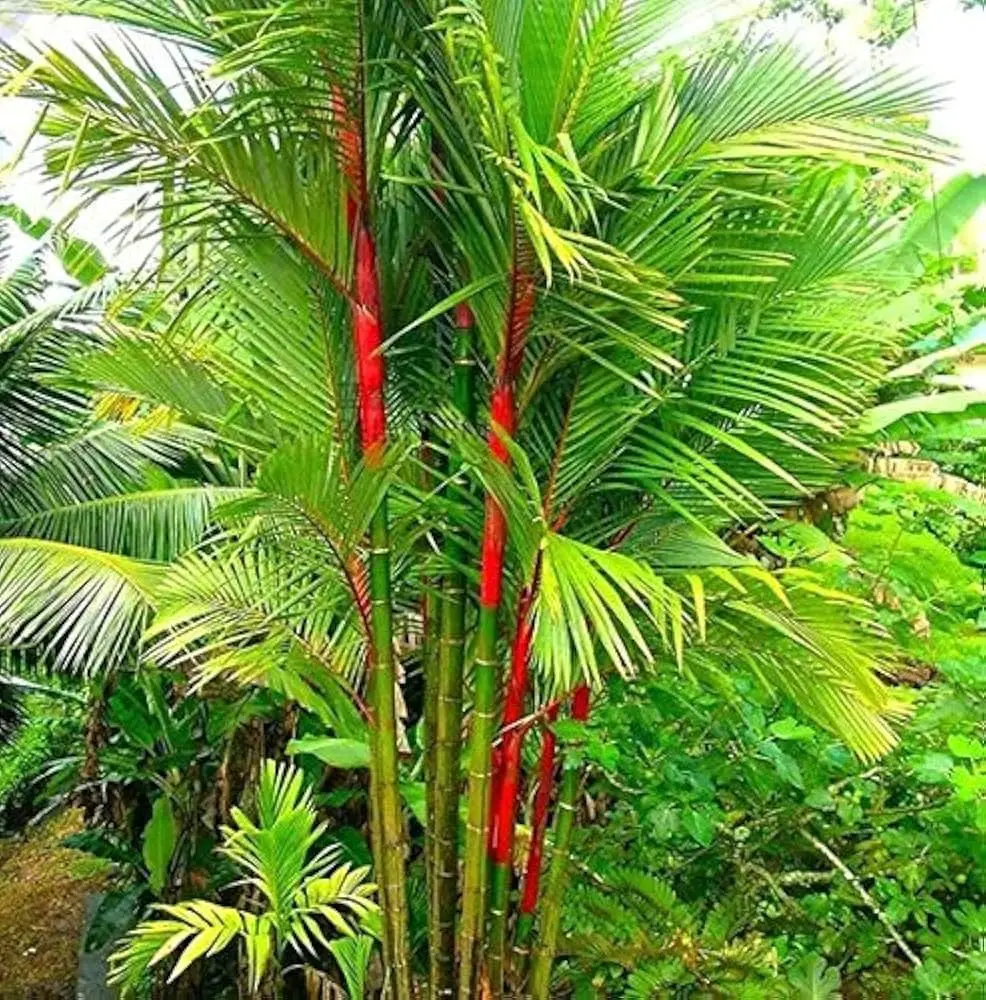
The Lipstick Palm, also called the Sealing Wax Palm, is famous for its vivid red crownshaft and leaf stems, which contrast strikingly with its glossy green fronds. Native to Southeast Asia, this tropical beauty is often grown as a centerpiece in luxurious landscapes or botanical gardens. It typically grows up to 20 feet tall in cultivation.
This palm requires full to partial shade and high humidity to thrive. It prefers consistently moist, well-draining soil rich in organic matter. The Lipstick Palm is sensitive to cold, drought, and dry air, so it needs a sheltered location or greenhouse in cooler climates. Regular watering and feeding with a balanced fertilizer are crucial for healthy growth.
Lipstick Palms are suitable for USDA zones 11–12. They are best grown in tropical areas like southern Florida, Hawaii, or protected indoor environments where warm, moist conditions can be maintained year-round.
Christmas Palm (Adonidia merrillii)
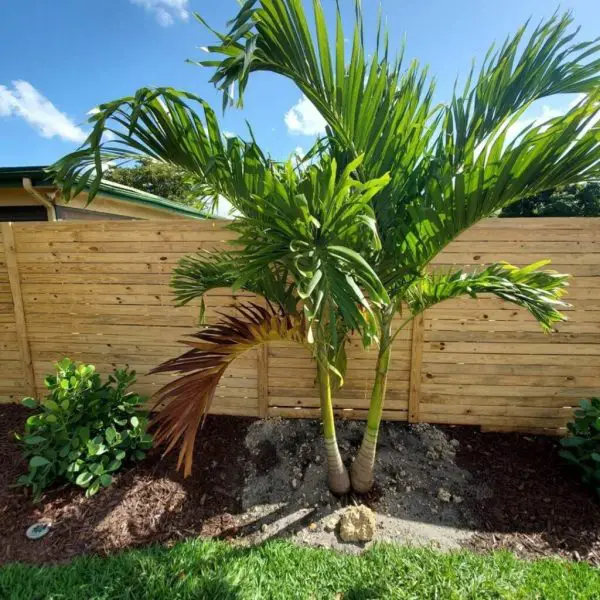
The Christmas Palm, also known as the Manila Palm, gets its name from the clusters of bright red fruits it produces in winter, resembling holiday ornaments. This single-trunked palm has a smooth, gray stem and a compact canopy of feather-like fronds. It typically grows to about 15 to 25 feet tall, making it ideal for small landscapes.
It prefers full sun to partial shade and thrives in well-draining soil. While relatively drought-tolerant, it benefits from regular watering, especially during dry spells. This palm responds well to light fertilization during the growing season and requires little pruning aside from removing spent fronds.
Christmas Palms thrive in USDA zones 10–11. They are commonly planted in southern Florida and other frost-free coastal areas, often used as ornamental features near entryways, driveways, or patios due to their manageable size and neat form.
Fishtail Palm (Caryota mitis)
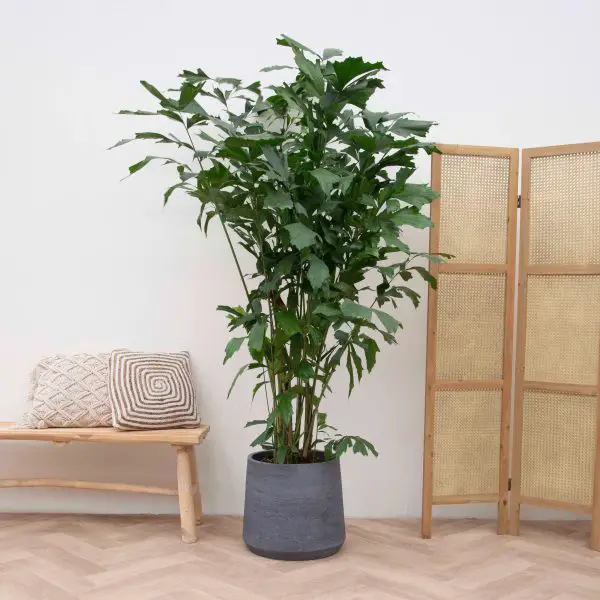
The Fishtail Palm is a multi-stemmed, clumping palm known for its unusual, jagged-edged fronds that resemble a fish’s tail. Native to Southeast Asia, this palm adds a unique tropical flair to gardens and can reach heights of 10 to 20 feet when grown outdoors. Its lush, bushy growth makes it a popular choice for screening and privacy.
It grows best in partial shade and moist, fertile soil with good drainage. Regular watering is necessary, especially during hot or dry weather. The Fishtail Palm appreciates humidity and should be protected from cold drafts and frost. Occasional feeding with a balanced palm fertilizer will help support vigorous growth.
This palm grows well in USDA zones 10–11. It’s commonly grown in tropical and subtropical regions or used as a houseplant in cooler climates, provided it receives enough light and humidity indoors.
Dwarf Palmetto (Sabal etonia)
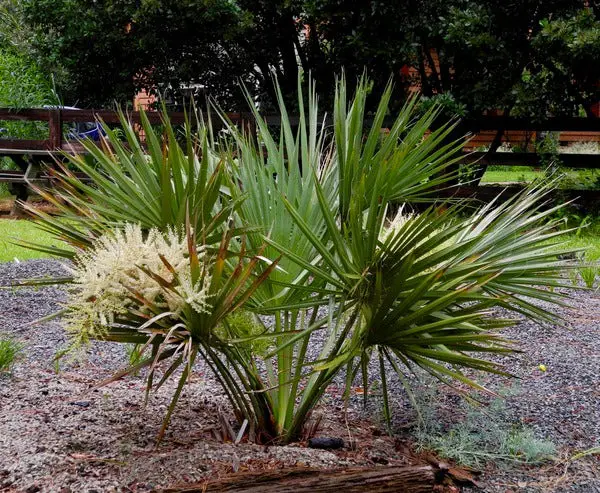
The Dwarf Palmetto is a compact, slow-growing palm native to the southeastern United States. It usually grows 3 to 6 feet tall and features fan-shaped, blue-green leaves emerging directly from the ground or a very short trunk. Its small stature and cold hardiness make it ideal for native plant gardens and naturalized landscapes.
It grows well in full sun to partial shade and adapts to various soil types, including dry, sandy, or slightly acidic soils. Once established, it is highly drought-tolerant and requires minimal maintenance. Occasional watering and mulching help retain moisture during dry periods. Pruning is rarely needed.
Dwarf Palmetto thrives in USDA zones 7–10. It is particularly suited for gardens in the southeastern U.S., including the Florida scrub, where it’s used for erosion control, wildlife habitats, and low-maintenance plantings.
Blue Latan Palm (Latania loddigesii)

The Blue Latan Palm is a striking ornamental palm from the Mascarene Islands, known for its bold, fan-shaped, silvery-blue leaves and thick, ornamental trunk. It can grow up to 20–30 feet tall and develops a dramatic architectural shape, making it a popular focal point in luxury or tropical gardens.
It prefers full sun and well-drained soil. This palm is relatively drought-tolerant once established but should be watered regularly while young. It does not tolerate freezing temperatures well, so protection may be needed in cooler climates. Fertilize in spring and summer to enhance foliage color and trunk development.
Blue Latan Palms grow in USDA zones 10–11. They thrive in warm, coastal, and subtropical areas, particularly in southern Florida and southern California, where their unique color and form add exotic elegance to landscapes.
Red Latan Palm (Latania lontaroides)
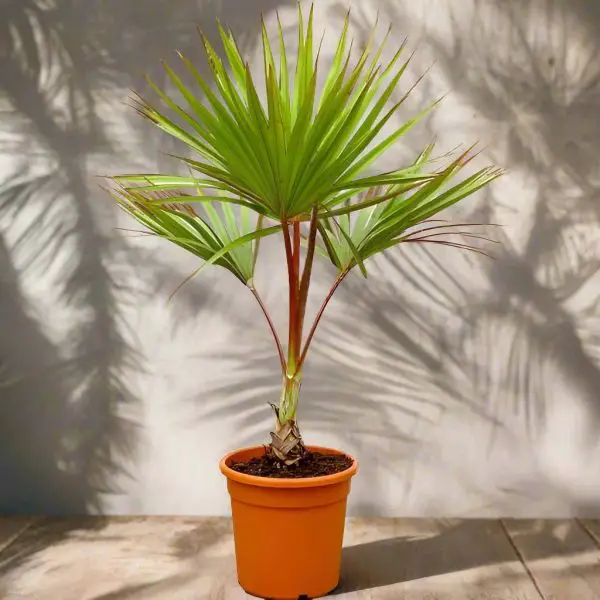
The Red Latan Palm is a rare and visually stunning species native to Réunion Island. It is known for its bright red to reddish-pink leaf stems and petioles, especially vivid in young plants. Its fan-shaped, bluish-green fronds sit atop a thick, solitary trunk, making it a showpiece in tropical and subtropical gardens.
This palm thrives in full sun and well-drained soils. It’s relatively slow-growing but easy to care for once established. While drought-tolerant, it benefits from regular watering during dry spells and occasional feeding with a balanced palm fertilizer to enhance its color and growth.
Red Latan Palm does best in USDA zones 10–11. It is commonly grown in warm coastal regions, such as southern Florida and southern California, where its vibrant leaf bases and sculptural form provide exotic elegance in landscape designs.
Yellow Latan Palm (Latania verschaffeltii)
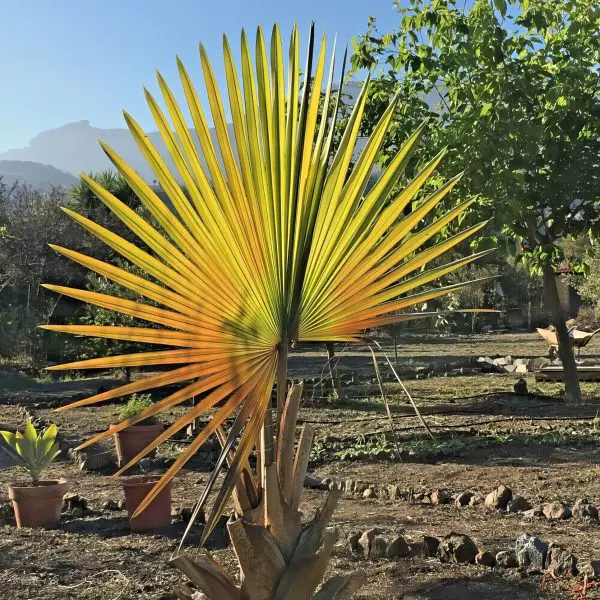
The Yellow Latan Palm is another striking species from the Mascarene Islands, closely related to the Red and Blue Latan Palms. It features large, fan-shaped, silvery-green leaves and petioles with yellowish tinges. As it matures, it develops a robust, columnar trunk and becomes a dramatic centerpiece in tropical landscapes.
It grows best in full sun and prefers sandy, well-drained soil. Although moderately drought-tolerant, young palms benefit from regular watering and protection from strong winds. Fertilize during the growing season to maintain vibrant leaf coloration and support healthy development.
Yellow Latan Palm is best suited for USDA zones 10–11. It is an excellent choice for coastal gardens and tropical landscapes where frost is not a concern, particularly in areas like southern Florida and the Caribbean.
Canary Island Date Palm (Phoenix canariensis)
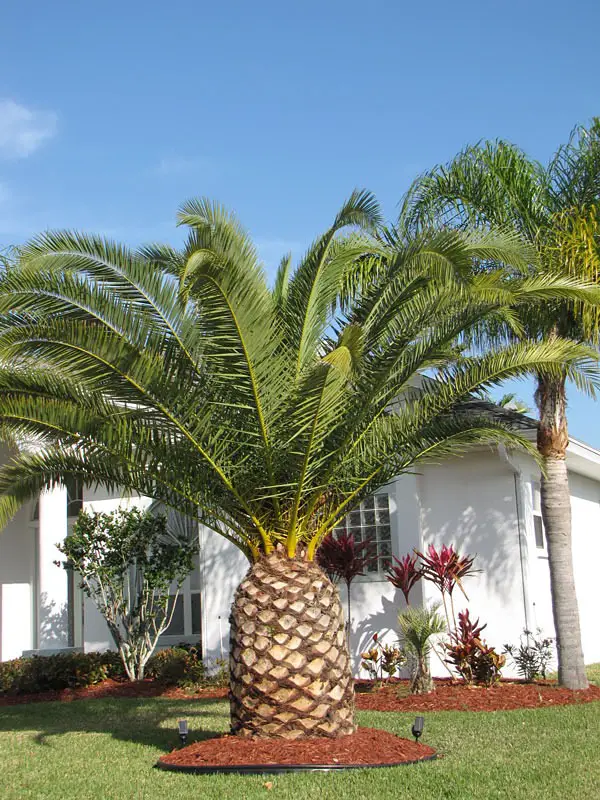
The Canary Island Date Palm is a majestic, large palm with a thick, sturdy trunk and a full crown of arching, feather-like fronds. Originating from the Canary Islands, it is often planted as a statement tree in avenues, parks, and upscale landscapes. It can reach up to 60 feet tall when mature.
This palm prefers full sun and well-drained soil, tolerating drought and occasional salt exposure once established. It requires deep watering during dry periods and occasional pruning to remove old, drooping fronds. Fertilizing with a palm-specific blend supports strong trunk development and leaf health.
Canary Island Date Palm thrives in USDA zones 9–11. It is widely planted in Mediterranean-style landscapes and warm regions like California, Arizona, and the southern U.S., where it adds a regal presence and long-lasting beauty.
Senegal Date Palm (Phoenix reclinata)
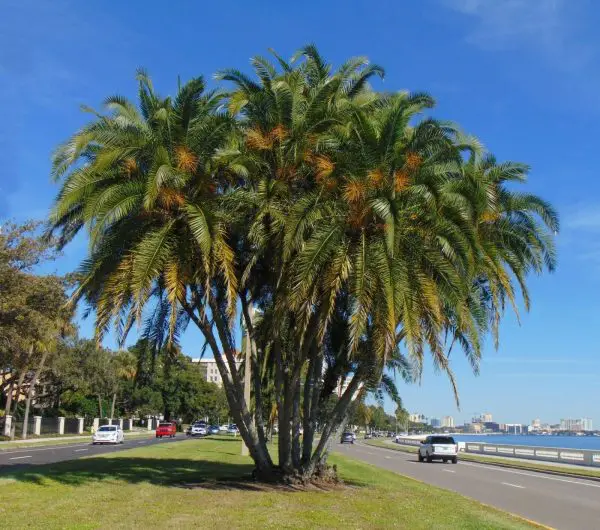
The Senegal Date Palm is a graceful, clumping species native to Africa. It grows multiple slender trunks that arch outward and are topped with feathery, dark green fronds. This palm creates a lush, tropical look and often grows 20 to 30 feet tall in cultivated settings.
It adapts well to full sun or partial shade and grows in a variety of soil types, including sandy or loamy soil with good drainage. It is drought-tolerant but benefits from occasional watering during prolonged dry periods. Minimal pruning is needed, mainly to maintain shape and remove dead fronds.
Senegal Date Palm grows best in USDA zones 9–11. It is a popular choice for tropical gardens in the southern U.S. and coastal areas where a naturalized or layered palm appearance is desired.
Wild Date Palm (Phoenix sylvestris)
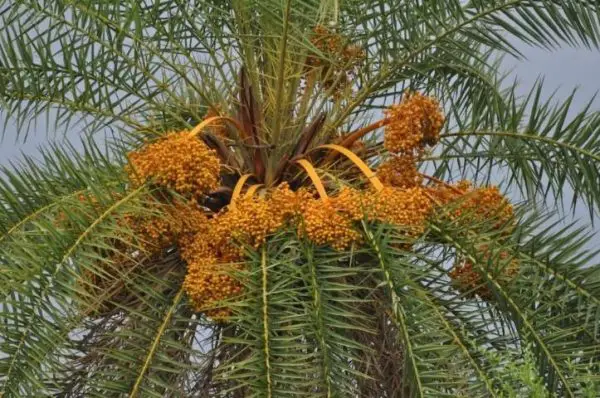
The Wild Date Palm, also called the Silver Date Palm or Indian Date Palm, is a tall, single-trunked palm native to India and Southeast Asia. It is known for its silvery-gray leaves and attractive trunk with leaf scars forming diamond-shaped patterns. It can grow up to 50 feet tall in optimal conditions.
It thrives in full sun and is highly adaptable to different soil types, including poor or rocky soils. This palm is drought-tolerant once established but appreciates deep, occasional watering. Prune off old fronds and fruit stalks to keep its appearance tidy.
Wild Date Palm grows well in USDA zones 9–11. It is used in both formal and naturalized landscapes across the southern U.S., particularly in dry or arid areas, due to its resilience and ornamental appeal.
Mediterranean Fan Palm (Chamaerops humilis var. argentea)
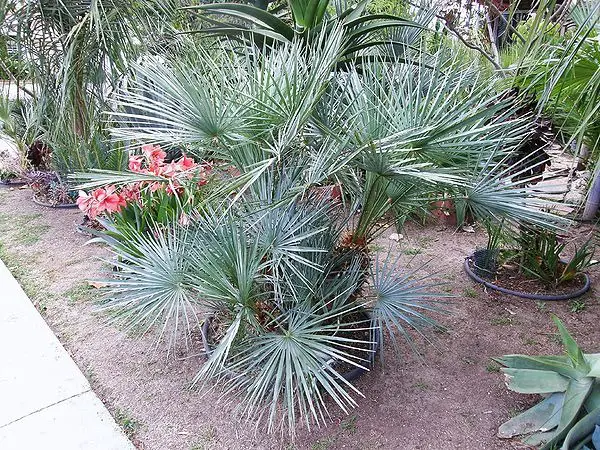
The Mediterranean Fan Palm (var. argentea), also called the Blue Mediterranean Fan Palm, is a silvery-blue variety of the species native to southern Europe and North Africa. It is a clumping palm that grows slowly to about 6 to 15 feet tall, making it ideal for smaller gardens or containers.
This palm thrives in full sun and well-drained soil and is one of the most cold-hardy palms available. It requires minimal maintenance and is highly drought-tolerant once established. Its slow growth and compact size make it a favorite for xeriscapes and rock gardens.
It is hardy in USDA zones 8–11, making it suitable for a wide range of climates, including the southwestern U.S. and parts of the Mediterranean. Its attractive silver foliage adds texture and color contrast in both formal and informal plantings.
Thatch Palm (Coccothrinax argentata)
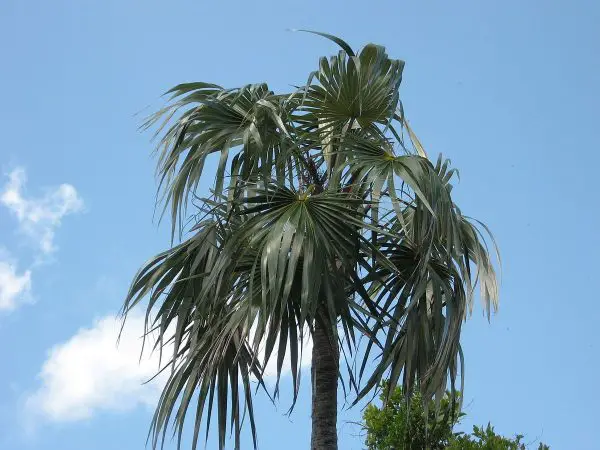
The Thatch Palm, also known as the Silver Thatch Palm, is a beautiful, slender-trunked palm native to Florida, the Bahamas, and parts of the Caribbean. It is known for its fan-shaped, silvery-green leaves that shimmer in the sunlight and create an airy, tropical appearance. This palm typically grows up to 20 feet tall and develops a graceful, upright habit.
It prefers full sun and well-drained, sandy soil. While slow-growing, the Thatch Palm is very low-maintenance once established. It is drought-tolerant and can also handle occasional salt spray, making it an excellent choice for coastal areas. Water regularly during dry spells and apply a balanced palm fertilizer during the growing season.
Thatch Palm thrives in USDA zones 10–11. It is well-suited for warm regions such as southern Florida and coastal areas of the Gulf Coast. Its compact size and salt tolerance make it perfect for beachside landscapes, poolside plantings, and small tropical gardens.
Yarey Palm (Copernicia berteroana)
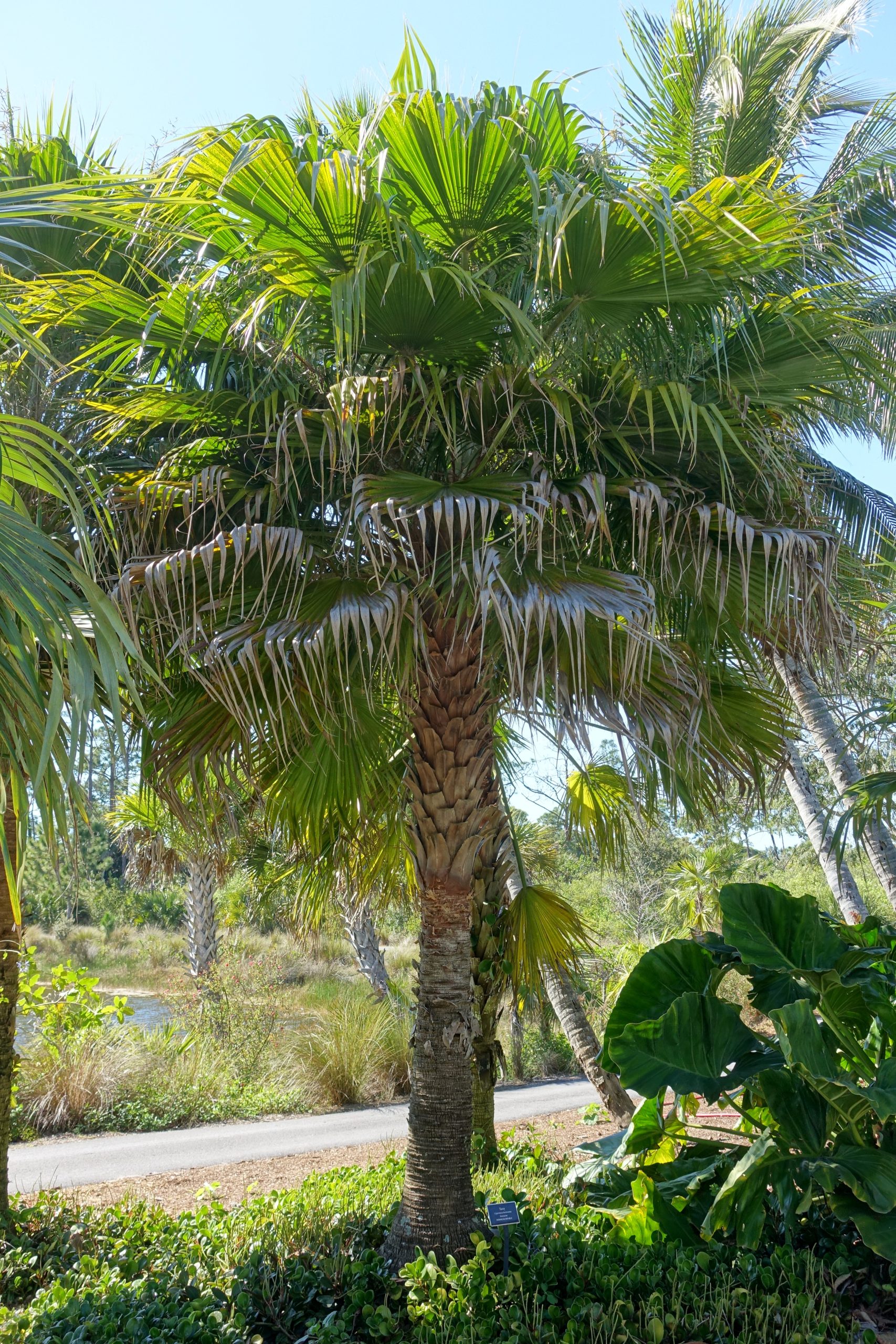
The Yarey Palm is a rare and striking species native to Hispaniola, part of the Copernicia genus known for its fan-shaped leaves and distinctive form. This palm typically grows with a solitary, straight trunk and a symmetrical crown of stiff, bluish-green fronds that add architectural interest to tropical landscapes. It can reach heights of 20 to 30 feet over time.
It grows best in full sun and well-drained soil, showing a high tolerance for heat and drought once established. This palm prefers warm, dry conditions and benefits from occasional watering and fertilization during active growth. Pruning is minimal and usually limited to removing spent fronds near the base.
Yarey Palm is suitable for USDA zones 10–11. Its drought resistance and elegant appearance make it an attractive option for tropical or desert-style gardens, especially in southern Florida or coastal southern California where cold is not a concern.
Exotic and Rare Palms
Jelly Palm (Butia capitata)
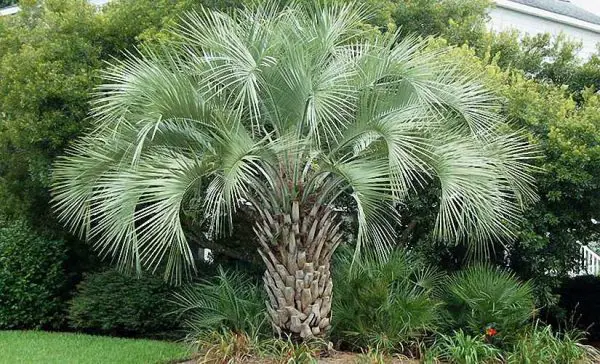
Jelly Palm, also known as Pindo Palm, is a slow-growing palm with a stout trunk and gracefully arching blue-gray fronds. This palm is well-known for producing small, sweet yellow-orange fruits that are often used to make jelly and wine. Its ornamental beauty and edible fruit make it a popular choice for landscapes.
It thrives in full sun but can also tolerate partial shade. Jelly Palm prefers well-drained soil and is moderately drought-tolerant once established. It is relatively low-maintenance and can handle brief cold spells, making it ideal for areas with mild winters.
This palm is hardy in USDA zones 8–11, withstanding temperatures as low as 15°F (-9°C). It can reach up to 20 feet tall but is often smaller in cultivation. It is a great choice for coastal gardens and subtropical landscapes, though care should be taken to place it away from walkways due to the mess from falling fruit.
Mule Palm (Butia x Syagrus hybrid)
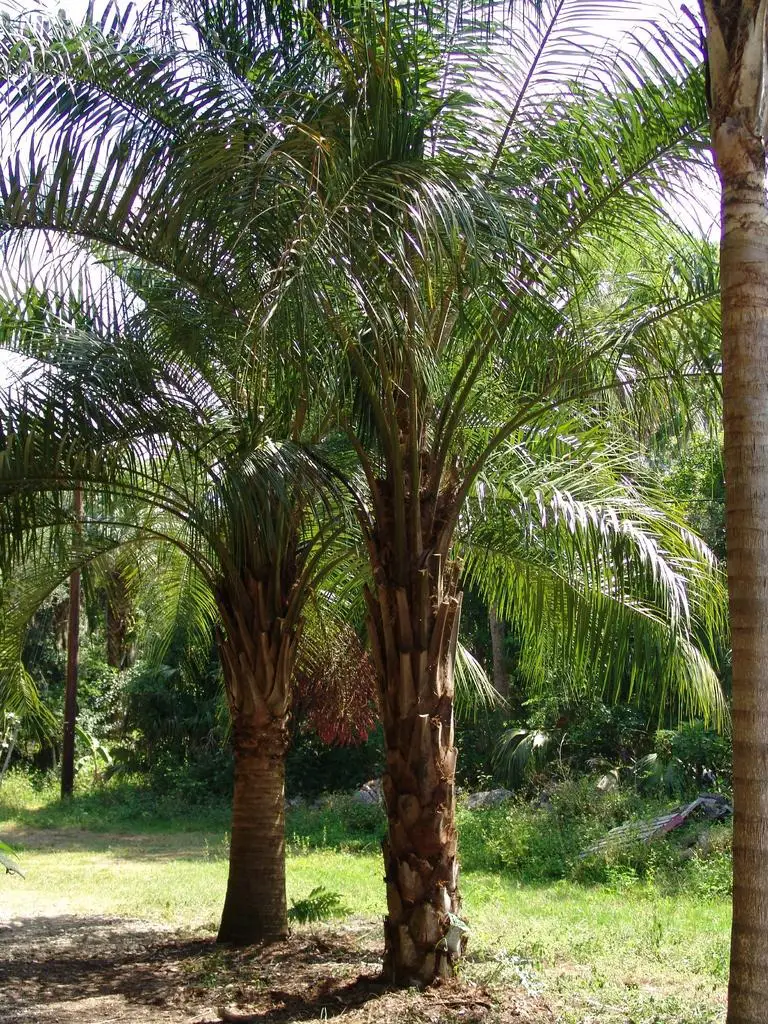
Mule Palm is a hybrid between the cold-hardy Butia capitata and the tropical Queen Palm (Syagrus romanzoffiana). This palm inherits the tropical appearance of its Queen Palm parent, but with better cold resistance. It has long, arching fronds and a graceful overall form, making it an attractive option for landscaping.
It thrives in full sun and requires well-drained soil. Mule Palm is moderately drought-tolerant once established, but regular watering during dry periods will promote better growth. It is also tolerant of a variety of soil types, as long as they drain well.
Hardy in USDA zones 8b–11, this palm can withstand temperatures as low as 15–20°F (-9 to -6°C). It is typically slow-growing and can reach 20–30 feet tall with a wide canopy. It is perfect for large gardens, coastal areas, and upscale landscaping.
Chilean Wine Palm (Jubaea chilensis)
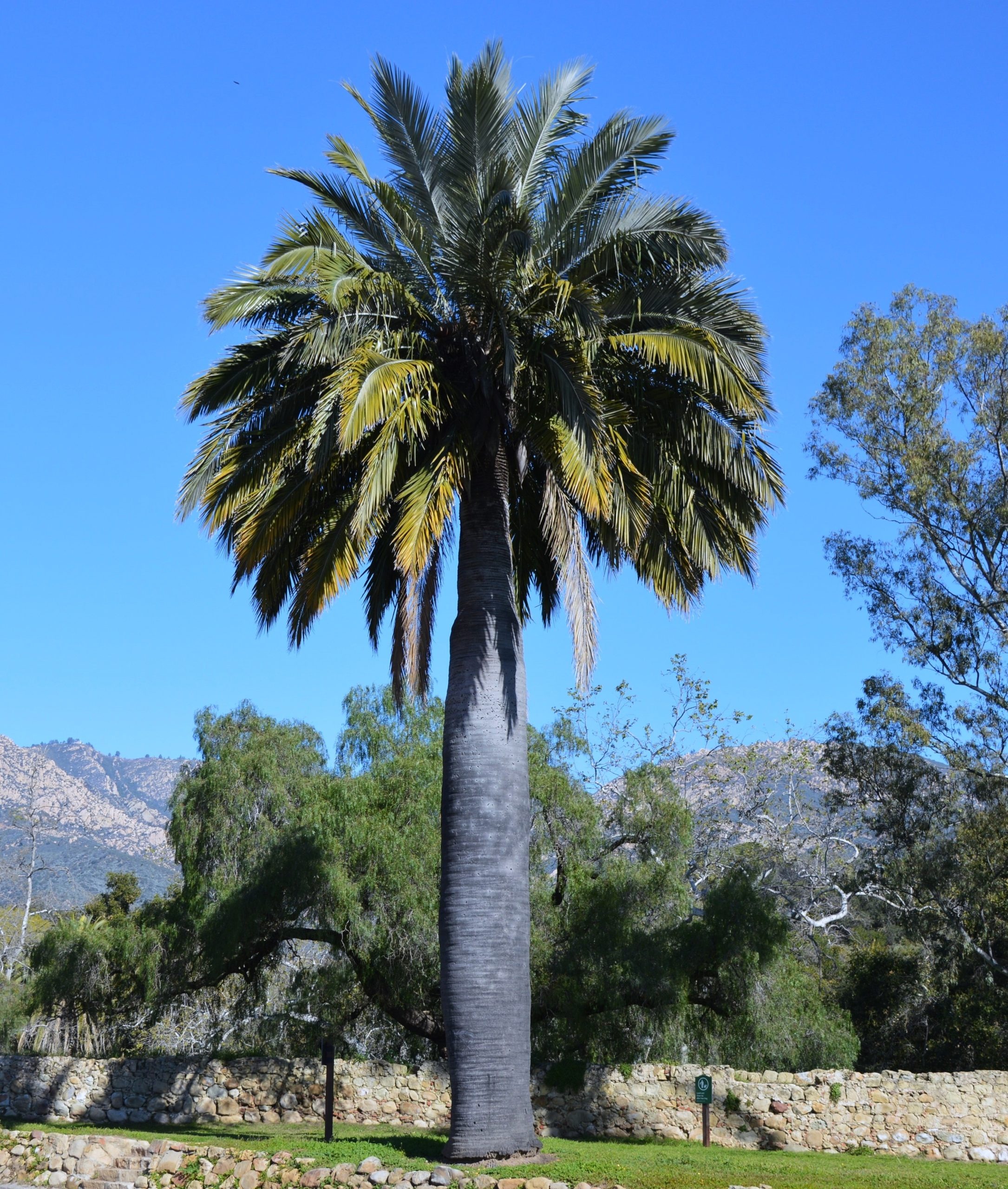
Chilean Wine Palm is a majestic and massive palm native to central Chile. It has a thick, stout trunk and large, graceful fronds that can create a striking focal point in gardens. This palm was historically tapped for its sap, which was used to make wine, giving it its name.
This palm grows best in full sun and requires well-drained soil to thrive. It is very slow-growing, but once established, it can withstand periods of drought. Chilean Wine Palm is also known for its long lifespan, often living for several centuries in the wild.
It is hardy in USDA zones 8–10 and can tolerate temperatures as low as 15°F (-9°C). This tree can grow up to 80 feet tall in the wild, but typically reaches 40–60 feet in cultivation. Due to its size, it is best suited for large landscapes or botanical gardens.
Lady Palm (Rhapis excelsa)
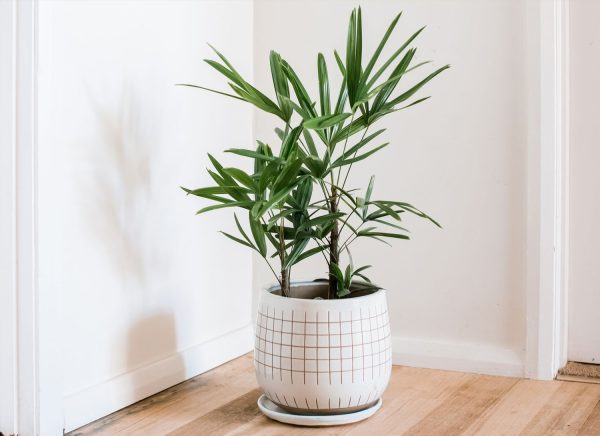
Lady Palm is a compact, multi-stemmed palm that features fan-shaped leaves divided into narrow segments. Its refined appearance and slow growth make it a popular choice for both indoor and outdoor landscaping. It is often used in tropical-themed gardens or as an ornamental plant in homes and offices.
Lady Palm prefers shaded locations with indirect light, making it an ideal candidate for indoor environments. It thrives in consistently moist, well-drained soil and should be watered regularly to keep the soil evenly moist, especially in warmer weather. It also appreciates higher humidity levels.
This palm is hardy in USDA zones 9–11 and can grow up to 10–12 feet tall outdoors, while indoor specimens tend to remain smaller, generally reaching 4–6 feet. Due to its ability to tolerate low light, it is commonly used in shaded garden beds or as an interior plant in offices and homes.
Bamboo Palm (Chamaedorea seifrizii)
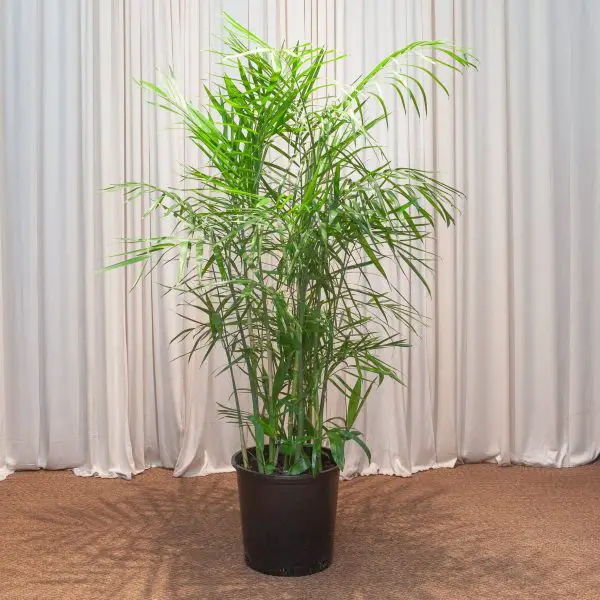
Bamboo Palm is a graceful, clustering palm known for its slender, bamboo-like stems and dense foliage. It is popular for both indoor and outdoor use due to its ornamental beauty and air-purifying qualities. The plant produces small yellow flowers and sometimes black berries, though it is primarily grown for its aesthetic appeal.
This palm prefers bright, indirect light or filtered sunlight but can also tolerate low light, making it an excellent choice for indoor environments. Bamboo Palm thrives in moist, well-drained soil and requires regular watering, especially during dry periods. It also benefits from occasional misting in dry climates to maintain high humidity levels.
Hardy in USDA zones 10–11, it typically grows up to 10–12 feet tall outdoors but stays smaller (4–6 feet) when grown indoors. This palm is ideal for small gardens, shaded outdoor areas, or as an air-purifying plant in homes and offices.
Florida Silver Palm (Coccothrinax argentata)
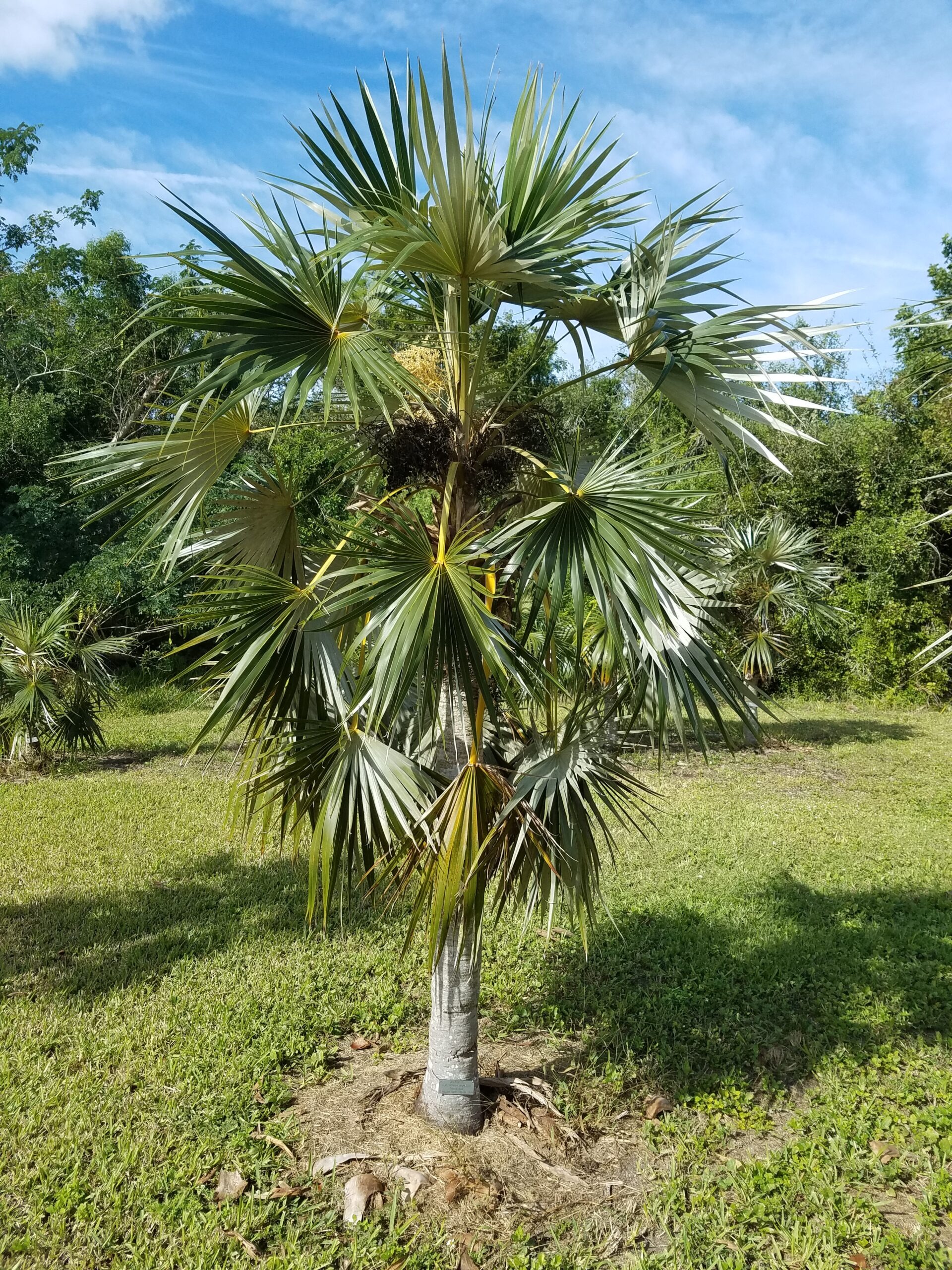
Florida Silver Palm is a small, slow-growing fan palm native to South Florida and the Caribbean. It is known for its striking silver underside of the fronds, which shimmer in the sunlight. The palm has a slender trunk and dense crown of foliage, adding a tropical touch to any landscape.
It prefers full sun but can tolerate some shade, especially in areas with hot summers. Florida Silver Palm requires well-drained, sandy soils and is very drought-tolerant once established. It is well-suited to coastal gardens and xeriscapes due to its salt tolerance and low water needs.
This palm is hardy in USDA zones 10–11 and typically grows 6–15 feet tall. It is an excellent choice for tropical-themed gardens, coastal landscapes, and areas where low-maintenance, salt-tolerant plants are needed. Its unique silver foliage makes it a standout in any garden.
Cuban Royal Palm (Roystonea regia)
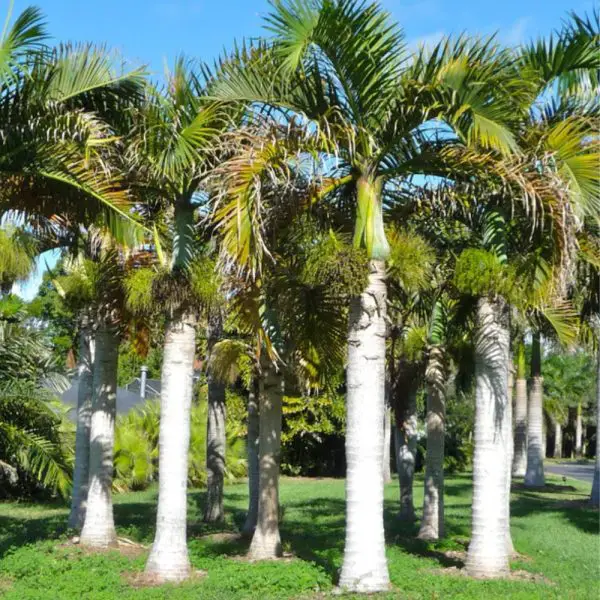
The Cuban Royal Palm is a tall, elegant species native to Cuba and parts of the Caribbean. It features a slender, straight trunk and a crown of feathery, arching fronds. This palm is widely recognized for its classic, tropical look and can grow up to 60 feet tall, with its smooth, gray trunk often adorned with distinctive leaf scars.
This palm thrives in full sun and well-drained soil, preferring warm climates. It is relatively low-maintenance once established but benefits from regular watering during dry periods. It is also tolerant of salt spray, making it a good choice for coastal areas. Fertilization with a balanced formula during the growing season promotes healthy growth and vibrant foliage.
Cuban Royal Palm is best suited for USDA zones 10–11. It is commonly found in tropical and subtropical regions, especially along the coasts of southern Florida and the Caribbean, where it provides a majestic silhouette against the sky.
Caribbean Royal Palm (Roystonea oleracea)
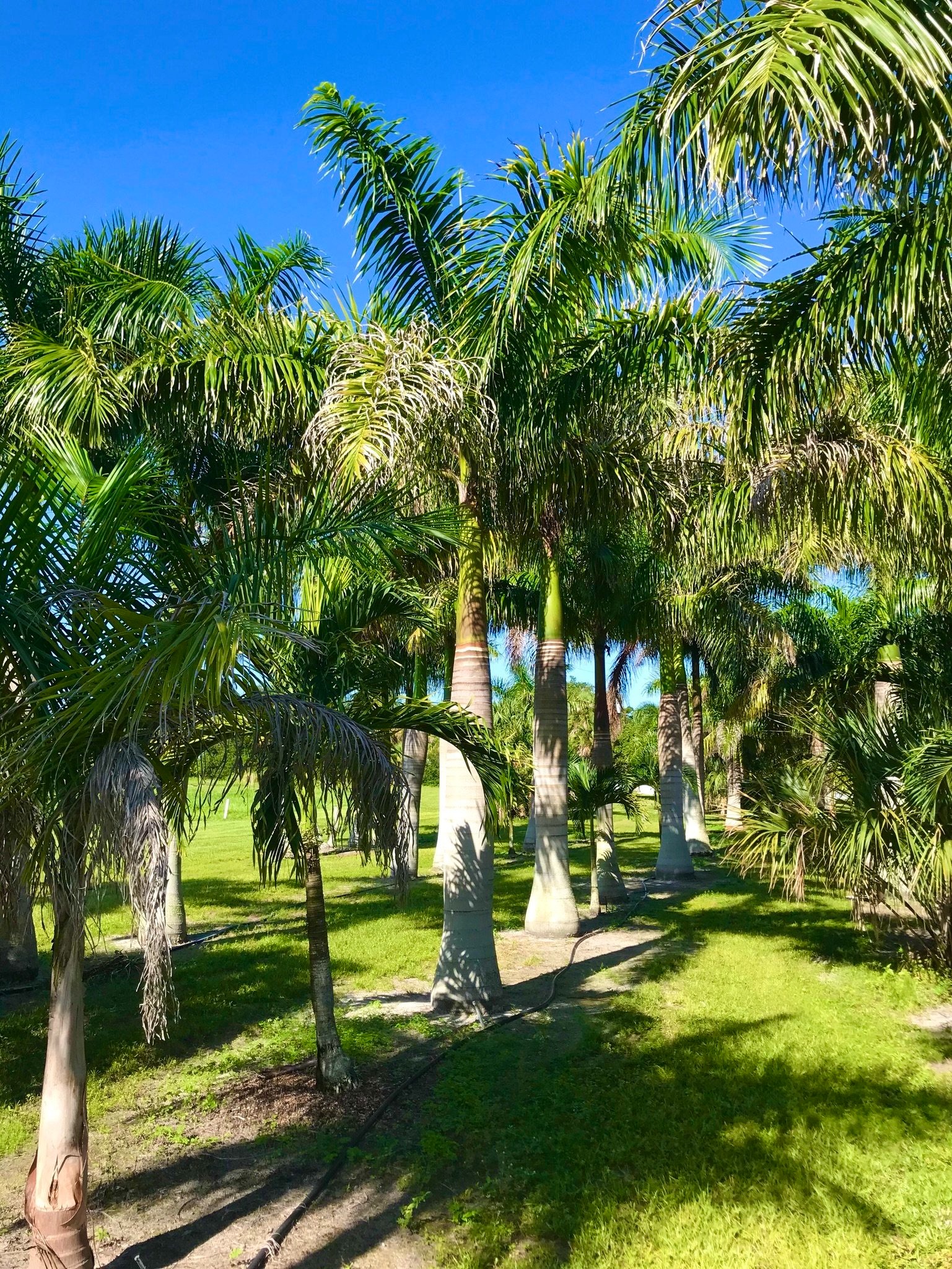
The Caribbean Royal Palm is a close relative of the Cuban Royal Palm, native to the Caribbean islands, particularly Puerto Rico and the Bahamas. It features a tall, slender trunk and large, arching, feather-like fronds. This palm can grow to a height of 50 to 60 feet, adding a dramatic vertical element to landscapes.
It thrives in full sun and well-drained, sandy soil. Like the Cuban Royal Palm, it is salt-tolerant and does well in coastal settings. It benefits from deep watering during dry spells and occasional feeding with palm fertilizer to support strong growth and frond development. Pruning is minimal, usually only necessary to remove dead fronds.
Caribbean Royal Palm is suited for USDA zones 10–11. Its ability to withstand saltwater makes it perfect for beachfront properties and coastal gardens, especially in southern Florida, the Gulf Coast, and tropical islands.
Bailey Palm (Dypsis pinnatifrons)
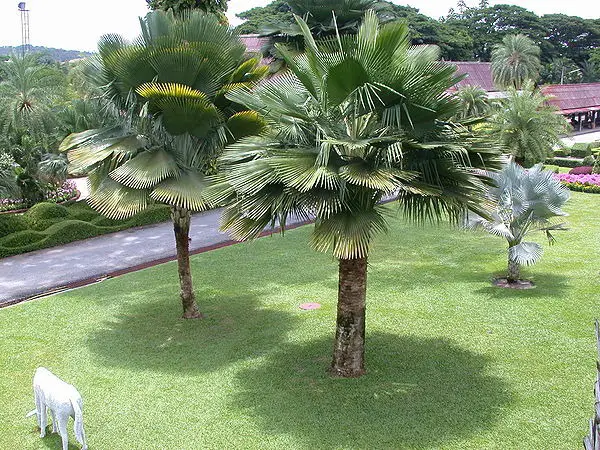
The Bailey Palm is a stunning, slow-growing species native to Madagascar. It features finely divided, feathery fronds that create a soft, cascading look. This palm typically grows to a height of 10 to 15 feet, making it a great choice for smaller gardens or container planting.
This palm prefers bright, indirect light and well-drained soil. It requires regular watering during the growing season but is somewhat drought-tolerant once established. The Bailey Palm benefits from occasional feeding with a balanced fertilizer to encourage its delicate, finely-textured foliage. It is also fairly resistant to pests and diseases.
Bailey Palm grows best in USDA zones 10–11. It is suitable for tropical and subtropical regions, including areas like southern Florida, southern California, and parts of Hawaii, where it can be grown in both gardens and indoor spaces with adequate light.
Teddy Bear Palm (Dypsis leptocheilos)
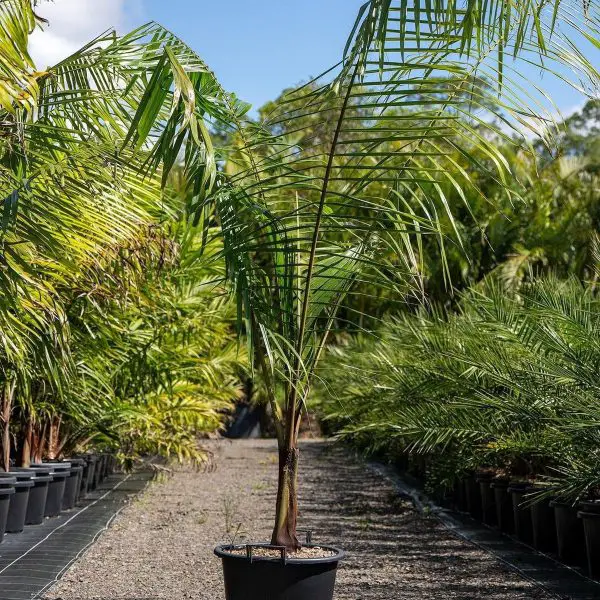
The Teddy Bear Palm, native to Madagascar, is a small, attractive palm that’s often admired for its unique, soft, fuzzy trunk. The trunk is covered with a dense, brownish fiber, giving it a teddy bear-like appearance. It has delicate, arching fronds that add to its charm. This palm grows to around 10 feet tall, making it perfect for small landscapes or as a decorative indoor plant.
It thrives in partial to full shade and prefers well-drained, sandy or loamy soil. While it is somewhat drought-tolerant, it should be watered regularly during the growing season to keep the soil slightly moist. Fertilizing with a palm-specific blend supports healthy growth and maintains its attractive appearance.
The Teddy Bear Palm is suitable for USDA zones 10–11. It is an ideal choice for shaded tropical or subtropical gardens and is also commonly grown as a houseplant in warmer regions like southern Florida and southern California, where it can be placed in patios or under trees.
Clumping Fishtail Palm (Caryota urens)

The Clumping Fishtail Palm is a distinctive species native to Southeast Asia. It is named for its unique, fishtail-shaped leaflets that give the fronds a feathery, exotic look. This palm is a clumper, meaning it grows multiple trunks that form a dense cluster. It can grow up to 30 feet tall and is ideal for creating a tropical ambiance in gardens.
It prefers full sun to partial shade and thrives in well-drained, moist soil. While drought-tolerant once established, regular watering during dry spells promotes faster growth. This palm benefits from occasional pruning to remove older fronds and prevent a cluttered appearance. It’s also a great plant for adding height and interest to tropical landscapes.
Clumping Fishtail Palm grows well in USDA zones 10–11. It is a popular choice in tropical gardens and is often used as a specimen plant or in multi-species plantings across warm coastal areas like southern Florida, Hawaii, and parts of southern California.
Ivory Cane Palm (Pinanga kuhlii)
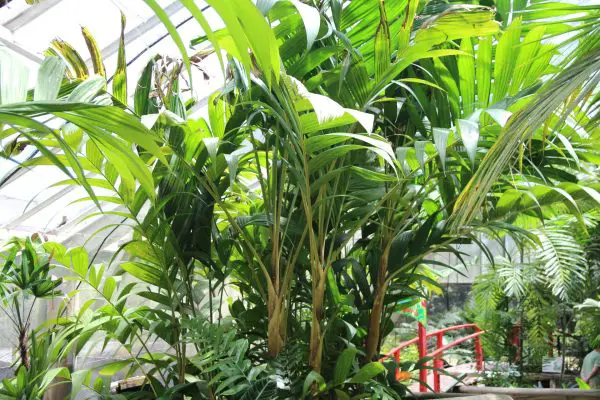
The Ivory Cane Palm, native to Southeast Asia, is a small, elegant palm known for its slender, creamy-white trunk and finely divided, arching fronds. It typically grows to a height of 10 to 12 feet, making it a perfect choice for smaller garden spaces or indoor containers. Its compact size and delicate appearance make it a great ornamental addition to tropical gardens.
It prefers shady conditions and well-drained, slightly acidic soil. The Ivory Cane Palm requires consistent moisture but can tolerate brief periods of drought once established. It benefits from regular watering, particularly during warmer months, and should be fertilized during the growing season with a slow-release fertilizer formulated for palms.
Ivory Cane Palm thrives in USDA zones 10–11, making it ideal for tropical and subtropical regions. It is commonly found in coastal and inland gardens of southern Florida, southern Texas, and parts of Hawaii, where it can be planted under trees or as an understory palm in shaded spots.
Blue Hesper Palm (Brahea armata)

The Blue Hesper Palm is a striking species native to the Baja California peninsula in Mexico. It is known for its silvery-blue, fan-shaped fronds that give it a bold, architectural appearance. This palm typically grows to a height of 15 to 30 feet, with a single, stout trunk. Its striking blue foliage adds a unique color to landscapes.
This palm thrives in full sun and well-drained, sandy or gravelly soil. It is drought-tolerant once established and can handle occasional neglect. Regular watering during dry spells will help promote growth, but it’s important to avoid overwatering. Fertilizing with a slow-release palm fertilizer during the growing season will support healthy foliage and trunk development.
Blue Hesper Palm is suitable for USDA zones 10–11. It is ideal for coastal gardens, dry landscapes, and drought-tolerant plantings, especially in southern California, southern Florida, and parts of Texas where the climate is warm and arid.
Mexican Blue Palm (Brahea decumbens)
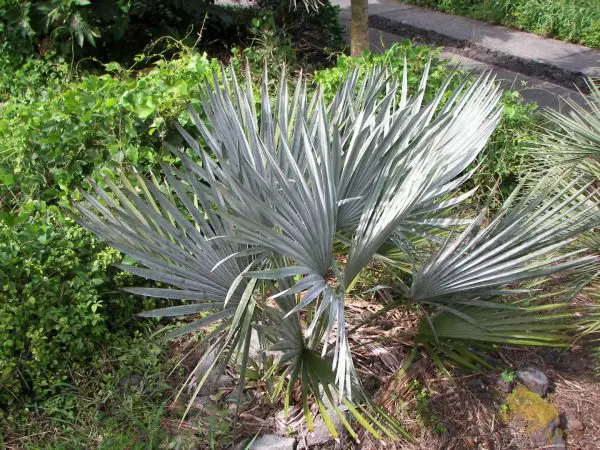
The Mexican Blue Palm is a rare and beautiful palm native to the deserts of northern Mexico. It features striking, bluish-gray, fan-shaped leaves that give the palm a dramatic, architectural look. This palm grows slowly, reaching a height of about 15 to 20 feet with a solitary, thick trunk, and its striking color contrasts beautifully with green foliage.
It prefers full sun and well-drained, sandy or rocky soil. Like other blue palms, the Mexican Blue Palm is highly drought-tolerant and thrives in dry conditions. Watering should be done carefully to avoid overwatering, and it benefits from occasional deep watering during prolonged dry periods. This palm is low-maintenance and requires little pruning.
The Mexican Blue Palm is best suited for USDA zones 9b–11. It is a great choice for desert-style landscapes and xeriscaping, particularly in regions like southern California, Arizona, and southern Texas, where it can tolerate heat and arid conditions.
Guadalupe Palm (Brahea edulis)

The Guadalupe Palm is a rare and endangered species native to the island of Guadalupe, off the coast of Baja California. It has large, fan-shaped leaves that are a rich green in color and can reach up to 20 feet in height. The trunk is stout and thick, with a distinctive grayish appearance. This palm is highly valued for its beauty and unique characteristics.
Guadalupe Palm thrives in full sun to partial shade and requires well-drained soil. It can handle dry conditions once established but benefits from regular watering during dry spells. A balanced fertilizer can help promote healthy growth, especially in the early years. It is a slow grower but can live for many years when properly cared for.
This palm is suited for USDA zones 10–11 and is ideal for coastal and warm, arid climates. It can be grown in southern California, southern Florida, and other subtropical regions, but its limited availability means it is often seen in collections or specialty gardens.
San Jose Hesper Palm (Brahea brandegeei)
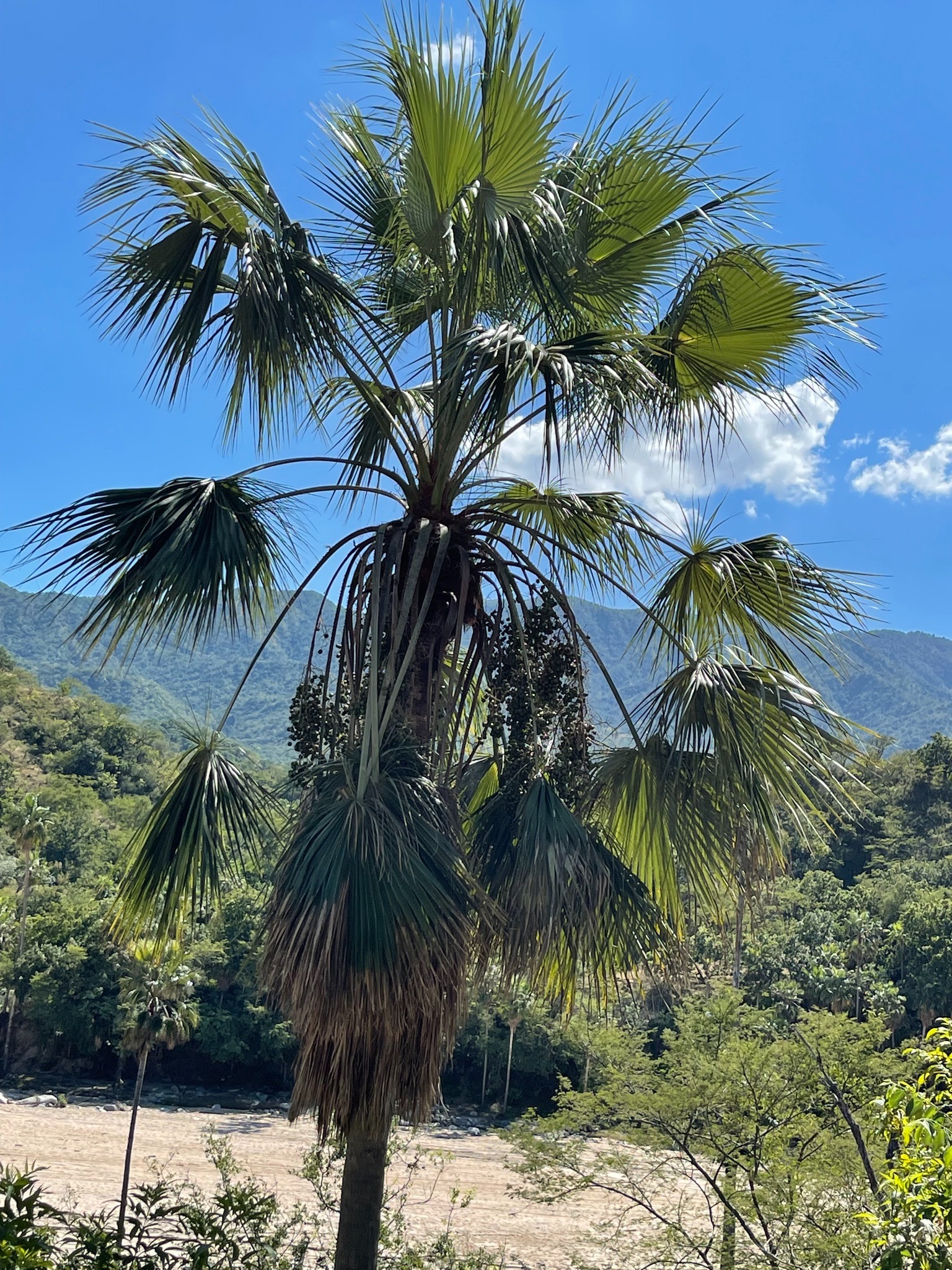
The San Jose Hesper Palm is a rare species native to Baja California, Mexico. It features blue-green, fan-shaped fronds that grow from a thick, stout trunk. This palm typically reaches a height of 15 to 25 feet, and its bold, striking appearance makes it a great focal point in landscaping. Its hardy nature and slow growth make it an attractive and long-lasting choice for gardens.
It prefers full sun and well-drained soil. While it is highly drought-tolerant once established, regular watering during dry periods helps it grow more robustly. This palm can withstand a variety of soil types but performs best in sandy, well-drained conditions. Fertilizing with a palm-specific formula supports overall health and encourages steady growth.
San Jose Hesper Palm is suitable for USDA zones 9b–11. It thrives in dry, coastal regions and is well-suited for southwestern U.S. gardens, including southern California and parts of Arizona, where it can tolerate heat and arid conditions.
Licuala Palm (Licuala grandis)

The Licuala Palm, native to Southeast Asia, is an exquisite ornamental palm known for its large, glossy, fan-shaped leaves that form a dense, umbrella-like crown. The leaves are deep green and circular in shape, with prominent veins that radiate outwards. This palm can grow up to 15 feet tall, making it a dramatic addition to shaded tropical gardens.
This palm prefers partial to full shade and moist, well-drained soil. It thrives in humid environments and benefits from regular watering to keep the soil evenly moist, especially in hot or dry climates. Fertilizing with a slow-release fertilizer will encourage lush, vibrant foliage. It’s important to protect the Licuala Palm from strong winds and direct sun, as its leaves can be damaged.
Licuala Palm is best suited for USDA zones 10b–11. It is ideal for shaded areas in tropical or subtropical climates, such as southern Florida, Hawaii, and parts of southern Texas, where the humidity and mild temperatures provide an ideal environment for growth.
Loulu Palm (Pritchardia pacifica)
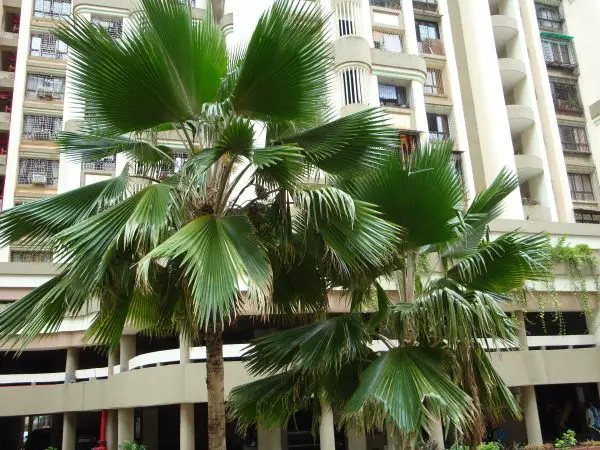
The Loulu Palm is a rare and striking species native to the Pacific Islands, particularly Hawaii. It features large, fan-shaped fronds that are dark green with a bluish tint. The leaves are held on a long petiole and have a unique, rounded shape, giving the palm a very tropical and exotic appearance. This palm typically grows to 10 to 20 feet tall.
Loulu Palm prefers partial to full shade and moist, well-drained soil. It is not particularly drought-tolerant and requires regular watering to maintain its lush appearance. Fertilizing with a balanced fertilizer during the growing season helps to maintain healthy growth and vibrant foliage. This palm should be protected from strong winds, as it is prone to damage.
Loulu Palm thrives in USDA zones 10b–11. It is best suited for tropical and subtropical regions such as southern Florida, Hawaii, and other coastal regions where the humidity is high and temperatures are consistently warm.
Macarthur Palm (Ptychosperma macarthurii)

The Macarthur Palm is a graceful, clumping palm native to northern Australia and Papua New Guinea. It features slender, green trunks with elegant feather-like fronds that arch gracefully, creating a lush, tropical appearance. Typically reaching heights of 15 to 25 feet, this palm forms multiple stems, making it a great choice for a privacy screen or tropical focal point.
This palm thrives in partial shade to full sun and prefers consistently moist, well-draining soil. It appreciates regular watering and benefits from high humidity, making it a great choice for tropical and subtropical landscapes. Applying a balanced fertilizer during the growing season will help maintain vigorous growth and lush foliage. It’s a fast grower and relatively easy to maintain when provided with the right conditions.
Macarthur Palm is best suited for USDA zones 10b–11. It grows well in southern Florida, coastal southern Texas, and Hawaii. In cooler zones, it can be grown as a container plant and brought indoors during winter months.
Joey Palm (Johannesteijsmannia altifrons)
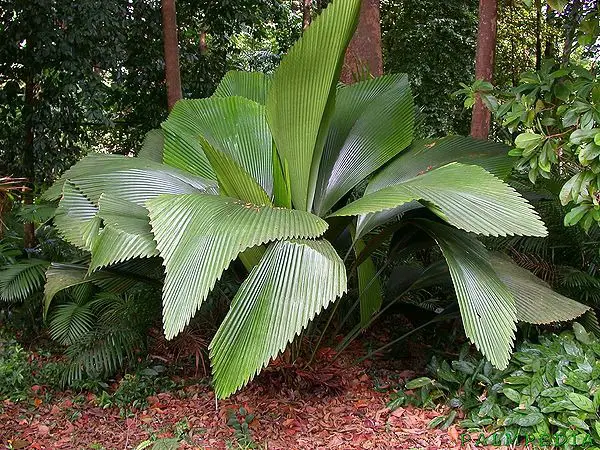
The Joey Palm is an extraordinary and rare palm species native to the rainforests of Malaysia and Thailand. It stands out for its gigantic, undivided, fan-shaped leaves that can reach up to 10 feet long. These dramatic, pleated leaves rise directly from the ground on short trunks, giving the palm a prehistoric and ornamental look that is truly unique.
Joey Palm thrives in deep shade and high humidity, mimicking the conditions of its native rainforest habitat. It requires rich, moist, well-draining soil and regular watering to keep the soil consistently damp. This palm is sensitive to cold and wind, so it must be planted in a protected, warm location or grown in a greenhouse or conservatory in cooler climates. It’s a slow-growing species that rewards patience with its exotic beauty.
The Joey Palm is only suitable for USDA zones 11 and above. In the United States, it can be grown outdoors in parts of southern Florida and Hawaii, or cultivated in climate-controlled environments like greenhouses or large indoor botanical collections in other regions.
Indoor-Friendly and Container Palms
Cascade Palm (Chamaedorea cataractarum)

The Cascade Palm is a dense, clumping palm with arching, glossy green fronds that resemble a waterfall in appearance—hence the name. Native to Mexico and Central America, it stays compact at around 3 to 6 feet tall, making it a suitable choice for small spaces or indoor containers.
Cascade Palms thrive in partial to full shade and require consistently moist, well-drained soil. They are sensitive to drought and do not tolerate standing water, so even watering is essential. These palms benefit from regular misting to increase humidity and occasional feeding with a balanced liquid fertilizer during the growing season.
Best grown in USDA zones 9b–11, the Cascade Palm is a good landscape option for shaded garden areas in warmer climates and works equally well as an indoor palm in cooler regions.
Metal Palm (Chamaedorea metallica)
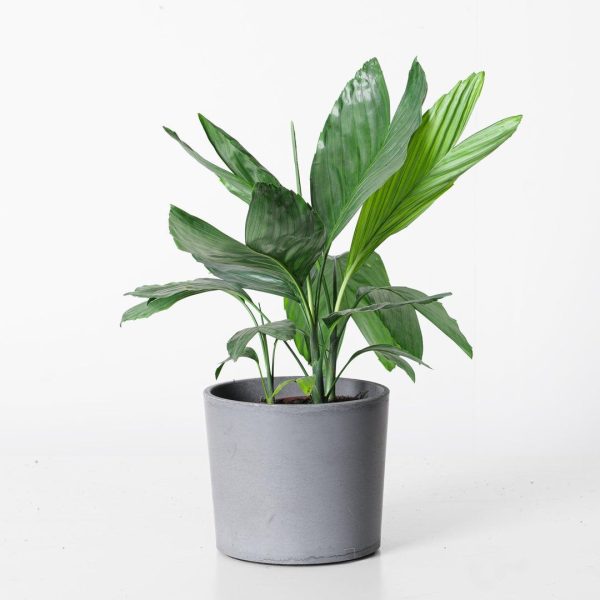
The Metal Palm gets its name from the striking metallic sheen of its dark green, paddle-shaped leaves. Native to the understory of Mexican rainforests, this palm has a single stem and typically reaches about 4 to 6 feet tall, making it a compact and eye-catching addition to interiors or shaded gardens.
It thrives in low-light to medium-light conditions and prefers consistently moist, well-draining soil. The Metal Palm does well indoors and requires minimal pruning. While it’s a slow grower, it’s relatively low-maintenance and appreciates occasional misting or placement in humid environments to replicate its native tropical habitat.
This palm is suited for USDA zones 10–11 but is more commonly used as an indoor or container palm across various climates. It’s a great choice for adding texture and color contrast to interior plant collections.
Flame Thrower Palm (Chambeyronia macrocarpa)
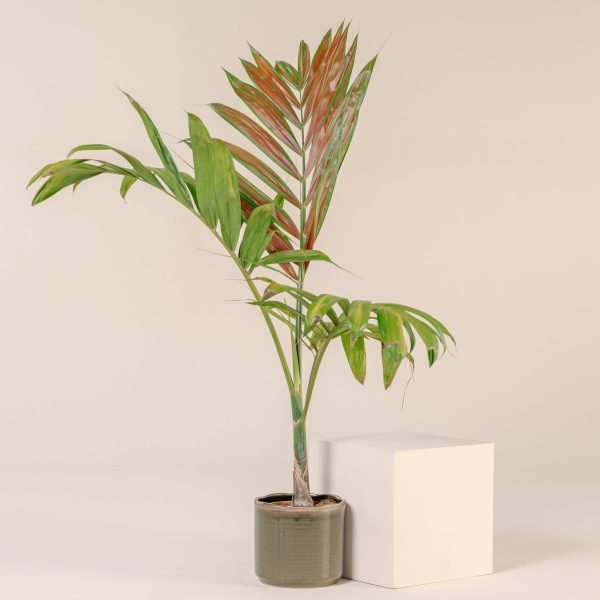
The Flame Thrower Palm is prized for its dramatic new leaves that emerge bright red before slowly maturing to a deep green. Native to New Caledonia, this palm has a solitary trunk and can grow up to 20 to 30 feet tall in ideal outdoor conditions. The colorful new growth makes it one of the most visually striking palms available.
Flame Thrower Palms thrive in partial shade to full sun, especially when young, and prefer rich, well-draining soil. They like consistent moisture but should not be left in soggy conditions. They benefit from occasional feeding with a slow-release palm fertilizer and do best in humid environments with some wind protection.
This palm is hardy in USDA zones 10b–11. It performs well in subtropical and tropical regions such as southern Florida and Hawaii, but in cooler zones, it should be grown in containers and brought indoors during colder months.
Seashore Palm (Allagoptera arenaria)

The Seashore Palm is a small, shrubby palm native to the coastal regions of Brazil. It features arching, silver-green fronds that grow from the base, giving it a windswept, fountain-like shape. Typically growing 3 to 6 feet tall, it’s especially valued for its high salt tolerance, making it ideal for beachside landscapes.
This palm prefers full sun to partial shade and well-draining sandy soil, which mirrors its native coastal habitat. It’s drought-tolerant once established and requires minimal maintenance beyond occasional watering during prolonged dry periods. Pruning is rarely needed except to remove old fronds.
Hardy in USDA zones 9b–11, the Seashore Palm is excellent for coastal gardens in warm climates. It’s a perfect fit for Florida, southern Texas, and other mild areas with exposure to salty air.
Dwarf Fan Palm (Livistona rotundifolia)

The Dwarf Fan Palm is an elegant, compact palm with round, glossy green fan-shaped leaves. Native to Southeast Asia, it usually grows to a height of about 5 to 7 feet, making it a popular choice for small landscapes or as a container plant both indoors and out.
It thrives in bright, indirect light but can also tolerate partial sun. The Dwarf Fan Palm prefers moist, well-draining soil and benefits from regular watering, especially during hot months. It appreciates a bit of extra humidity and will benefit from monthly feeding during the growing season with a general-purpose palm fertilizer.
Best suited for USDA zones 10–11, this palm is often used as an ornamental in tropical and subtropical gardens or kept indoors in cooler climates where it adds a touch of the tropics to interior décor.
Ruffled Fan Palm (Licuala peltata)

The Ruffled Fan Palm is an exotic and visually stunning palm known for its large, circular, pleated leaves that resemble hand fans. Native to Southeast Asia, particularly Thailand and Malaysia, this palm can grow up to 10 feet tall in ideal conditions, though it often remains shorter in containers. Its symmetrical foliage adds a dramatic flair to tropical gardens or indoor plant collections.
This palm thrives in partial shade and needs consistently moist, well-draining soil. It prefers high humidity and warm temperatures, making it perfect for greenhouses or protected outdoor spaces in warm climates. Avoid direct, harsh sun, as it can scorch the delicate leaves. Regular misting and balanced fertilizer during the growing season help maintain its lush appearance.
Ruffled Fan Palm is hardy in USDA zones 10–11. It’s best grown in tropical or subtropical areas like Hawaii and southern Florida, or kept in containers indoors in cooler regions.
Burretiokentia Palm (Burretiokentia hapala)
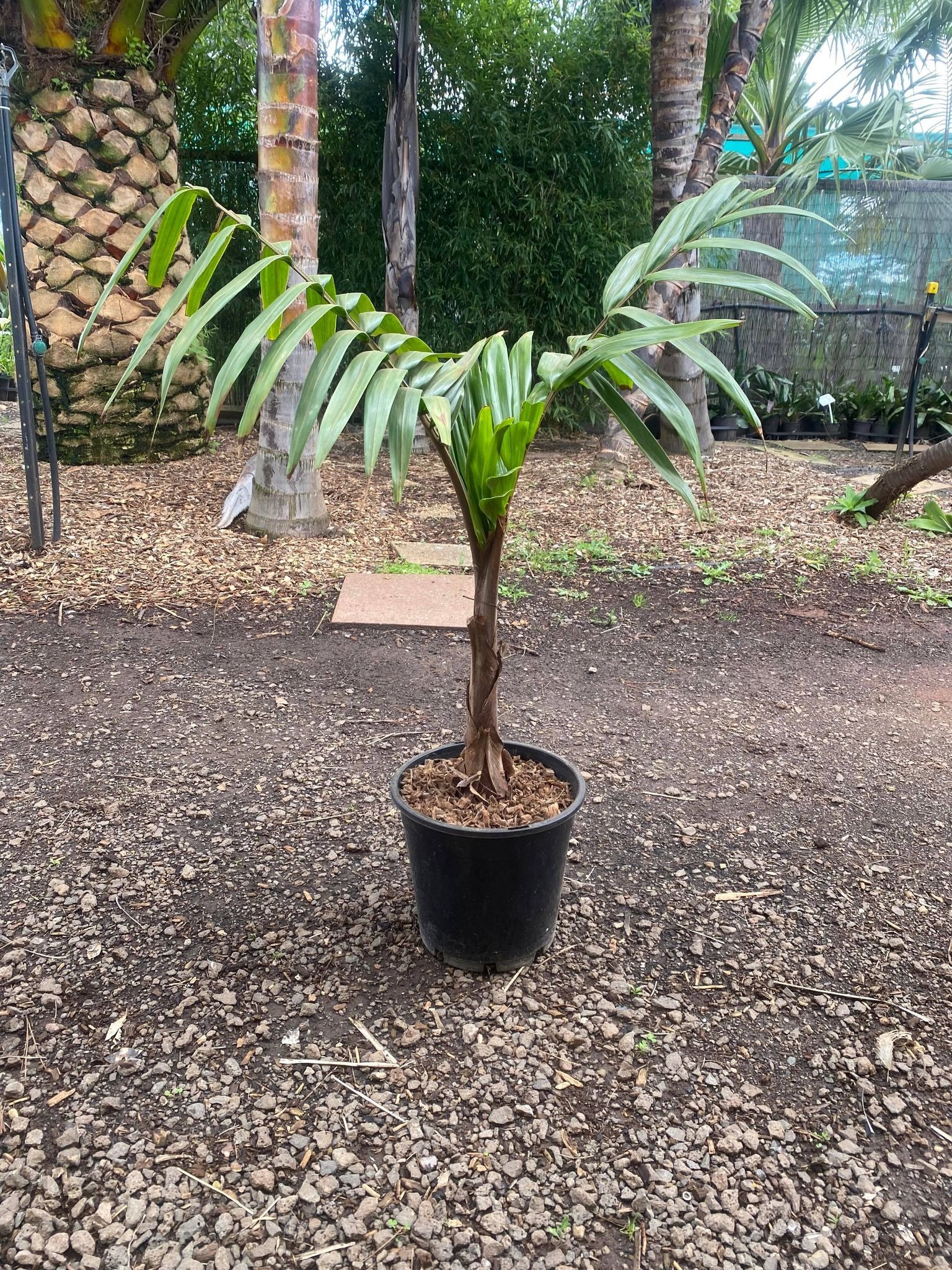
The Burretiokentia Palm is a graceful and lesser-known palm species native to New Caledonia. It features a slender, solitary trunk topped with gently arching, feather-like fronds. Reaching heights of 15 to 30 feet in the wild, it is a slow-growing palm prized for its elegant form and ornamental value.
This palm does best in filtered sunlight to partial shade and thrives in rich, well-draining soil with consistent moisture. It prefers a humid, tropical climate and benefits from regular watering, especially in dry periods. Mulching helps retain moisture, and a slow-release palm fertilizer can be applied during the warmer months to support steady growth.
Burretiokentia hapala is suitable for USDA zones 10b–11. It’s ideal for collectors, tropical garden enthusiasts, or as a feature palm in protected landscapes where frost is not a concern.
Kerriodoxa Palm (Kerriodoxa elegans)
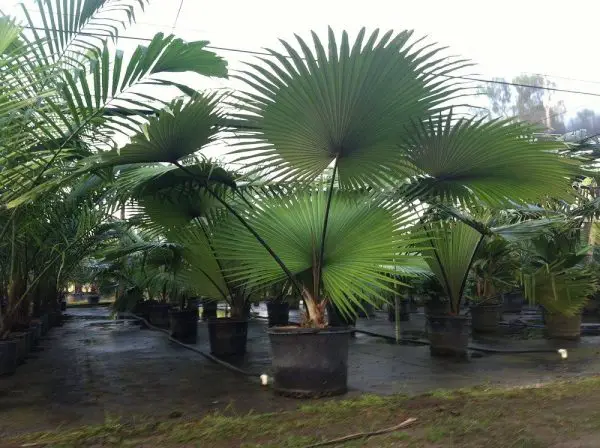
Also known as the White Elephant Palm, the Kerriodoxa Palm is a rare and beautiful palm from Thailand, valued for its striking contrast of dark green tops and silvery-white undersides on its fan-shaped leaves. It is a solitary, slow-growing palm that typically reaches about 10 to 12 feet in height under cultivation.
It prefers deep shade to partial sunlight and moist, well-drained soil rich in organic matter. This palm thrives in humid environments and should be protected from strong winds and full sun. Regular watering and a tropical fertilizer during the growing season will help maintain its vibrant foliage and healthy growth.
Kerriodoxa elegans is hardy in USDA zones 10–11. Due to its rarity and unique appearance, it’s often grown in botanical gardens or by palm collectors in frost-free, humid areas.
Wendlandia Palm (Wendlandiella gracilis)

The Wendlandia Palm is a petite and graceful palm native to the rainforests of Central and South America. This clustering palm stays small, typically growing 3 to 5 feet tall, and features thin stems and fine-textured, feathery leaves. Its delicate form and manageable size make it perfect for small gardens or indoor containers.
It prefers bright, indirect light or filtered sun and thrives in moist, well-drained soil with regular watering. Wendlandia Palms benefit from high humidity and occasional misting. They respond well to a balanced liquid fertilizer applied monthly during spring and summer and require little pruning beyond the removal of spent fronds.
This palm is best suited for USDA zones 10–11. It’s an excellent choice for shaded tropical gardens, understory planting, or as an indoor specimen in temperate zones where it adds a soft, airy texture to plant arrangements.
More Species from Around the Globe
Zombie Palm (Zombia antillarum)

The Zombie Palm is a striking and unusual palm native to Hispaniola in the Caribbean. It has a slow-growing, clumping habit and features stiff, pinnate leaves. Its most distinctive feature is its trunk, which is covered in a dense mat of sharp spines, giving it a wild, armored appearance that deters animals and adds a dramatic element to landscapes.
Zombie Palms prefer full sun to partial shade and well-draining, sandy soils. They are drought-tolerant once established and should be watered moderately, allowing the soil to dry out between waterings. These palms benefit from occasional feeding with a palm-specific fertilizer during the growing season to support healthy fronds and growth.
This palm thrives in USDA zones 10–11. It is well-suited for xeriscaping, coastal gardens, or as a conversation-starting focal point in tropical landscapes where frost is not an issue.
Loulu lelo Palm (Pritchardia remota)
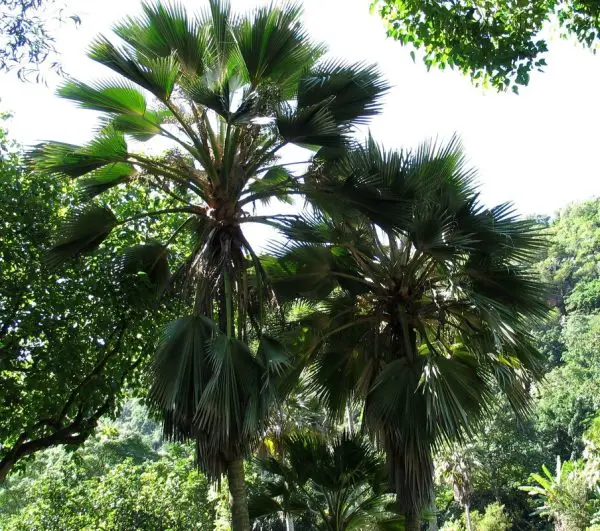
The Loulu lelo Palm is a rare and endangered palm species endemic to the Hawaiian island of Nihoa. It features fan-shaped leaves with a silvery underside and a smooth, slender trunk. This slow-growing palm typically reaches up to 10 to 20 feet tall and is cherished for its simple, elegant structure and cultural importance in Hawaii.
It grows best in full sun to light shade and prefers well-drained, slightly alkaline soils. The Loulu lelo is relatively drought-tolerant once established, though it appreciates regular watering during dry spells. Adding mulch around the base helps retain moisture and protect roots from temperature swings.
Pritchardia remota is suitable for USDA zones 10–11. It’s an excellent palm for collectors, conservation gardens, or those interested in preserving Hawaii’s unique botanical heritage.
Andaman Palm (Phoenicophorium borsigianum)
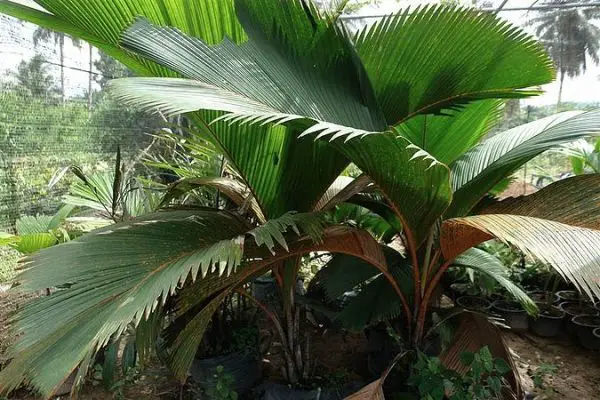
The Andaman Palm, also known as the Seychelles Stilt Palm, is native to the Seychelles Islands and admired for its distinctive, deeply pleated, glossy leaves. Its trunk is slender with stilt-like roots and topped with a vivid red crownshaft. The palm can grow up to 30 feet tall in ideal conditions.
It prefers partial shade and well-drained, rich, and slightly acidic soil. This palm needs consistent moisture and high humidity to thrive, making it perfect for tropical or greenhouse settings. Avoid exposing it to strong winds or full sun, which can damage the leaves. Fertilize every few months with a balanced formula to support lush growth.
The Andaman Palm is hardy in USDA zones 10b–11. Due to its tropical needs, it’s best suited for warm coastal gardens or indoor conservatories in frost-free regions.
Solitary Fishtail Palm (Caryota maxima)
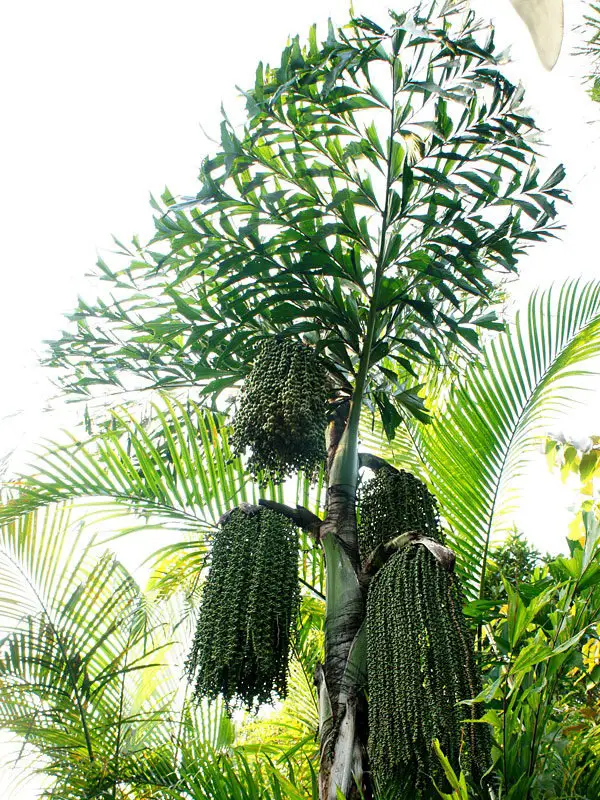
The Solitary Fishtail Palm is a majestic palm species native to Southeast Asia. It is known for its large, bipinnate leaves that resemble the tail of a fish and its towering growth habit that can reach up to 60 feet tall. This monocarpic palm blooms once and then dies after producing fruit, though it may take many years before flowering.
This palm thrives in full sun to partial shade and prefers moist, well-drained soil enriched with organic material. Regular watering and humidity are essential, especially in hot climates. It should be planted in a location with room to grow vertically, as it can become a towering focal point over time.
Caryota maxima is hardy in USDA zones 9b–11. It’s a bold choice for large tropical landscapes or estate gardens, where its dramatic size and foliage can be fully appreciated.
Chamaedorea ernesti-augusti
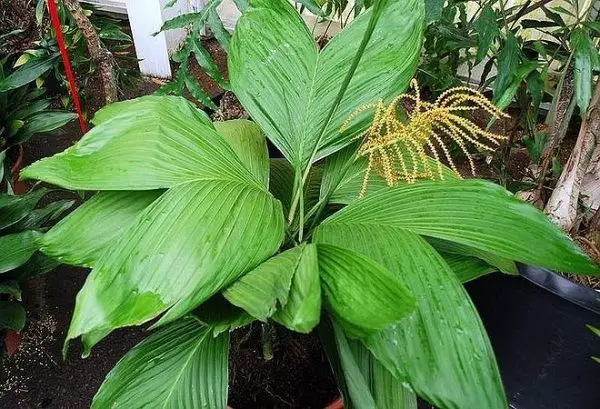
Chamaedorea ernesti-augusti is a compact and graceful palm native to the rainforests of Central America. It is a clustering palm with broad, simple leaves that are often not divided, giving it a unique and lush appearance compared to other feather palms. Its tidy growth and modest height make it a favorite among indoor plant lovers.
It prefers low to medium indirect light and thrives in well-drained, peat-rich soil. Water the plant consistently, allowing the top layer to dry slightly between waterings. It enjoys humidity and benefits from occasional misting. Avoid overwatering and ensure proper drainage to prevent root rot.
This palm is hardy in USDA zones 10–11. It’s ideal for indoor containers, shaded patios, or as part of a tropical understory planting in frost-free climates.
Manilla Palm (Veitchia merrillii)
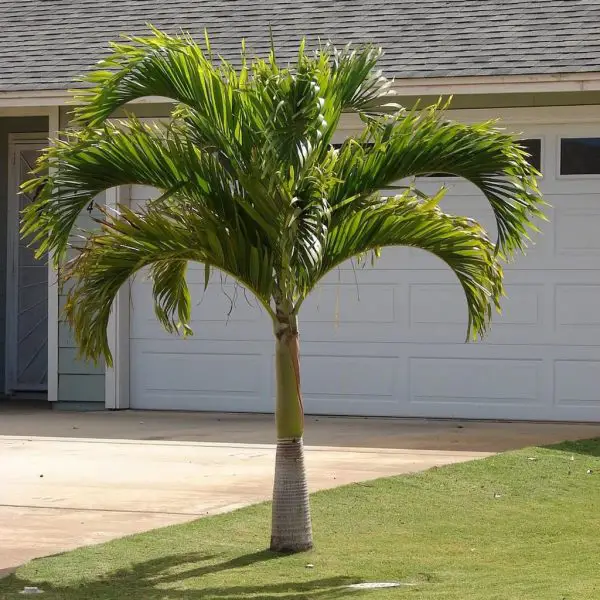
The Manilla Palm, also known as the Christmas Palm, is native to the Philippines and is prized for its symmetrical, feather-like fronds and smooth gray trunk. It is a single-trunk palm that usually grows to about 20 feet tall and often produces red berries around the holiday season, which gives it the nickname “Christmas Palm.”
This palm prefers full sun but will tolerate partial shade and should be planted in well-draining soil. It does best with regular watering but can handle short dry periods once established. Fertilize with a palm-specific formula three times a year to maintain healthy foliage and fruit production.
Manilla Palms are suitable for USDA zones 10–11. They are perfect for residential gardens, poolside plantings, or lining driveways in warm, frost-free environments.
Pritchardia hillebrandii

Pritchardia hillebrandii, commonly known as the Molokai fan palm, is a beautiful and relatively rare species native to the Hawaiian island of Molokai. This small to medium-sized palm typically grows up to 20 feet tall and features wide, fan-shaped leaves with silvery undersides, giving it a unique and ornamental appearance.
It prefers full sun in coastal environments and partial shade inland. The palm grows best in well-draining soil and needs moderate watering, especially when young. Once established, it is fairly drought-tolerant and low maintenance, making it suitable for xeriscaping in tropical or subtropical regions.
Pritchardia hillebrandii thrives in USDA zones 10–11. It’s an excellent choice for collectors, conservation-focused gardens, or tropical landscapes looking for native Hawaiian flair.
Arenga Palm (Arenga engleri)
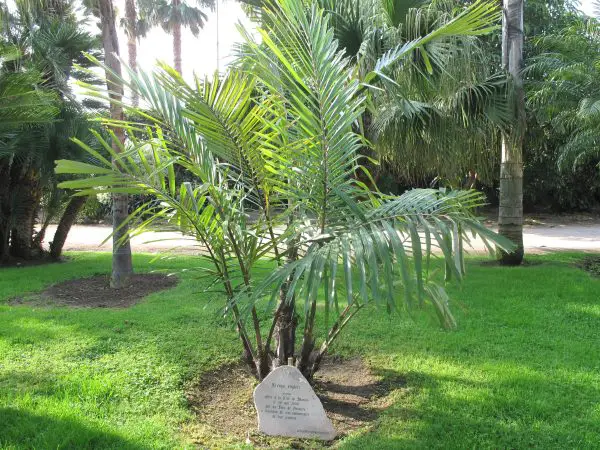
The Arenga Palm, also known as the Dwarf Sugar Palm or Formosa Palm, is a clumping palm native to Taiwan and the Ryukyu Islands of Japan. It has feathery, dark green leaves with silvery undersides and grows to a height of 6 to 10 feet, making it a compact option for smaller gardens or indoor settings.
Arenga engleri prefers partial shade and thrives in moist, well-drained soil rich in organic matter. It benefits from consistent watering, especially in warm weather, but can tolerate short dry spells once established. Regular mulching and an occasional dose of palm fertilizer help promote healthy growth.
This palm is hardy in USDA zones 9–11 and is often used as a privacy screen or understory plant in subtropical landscapes. Its compact habit and cold tolerance make it more versatile than many tropical palms.
Arikury Palm (Syagrus schizophylla)
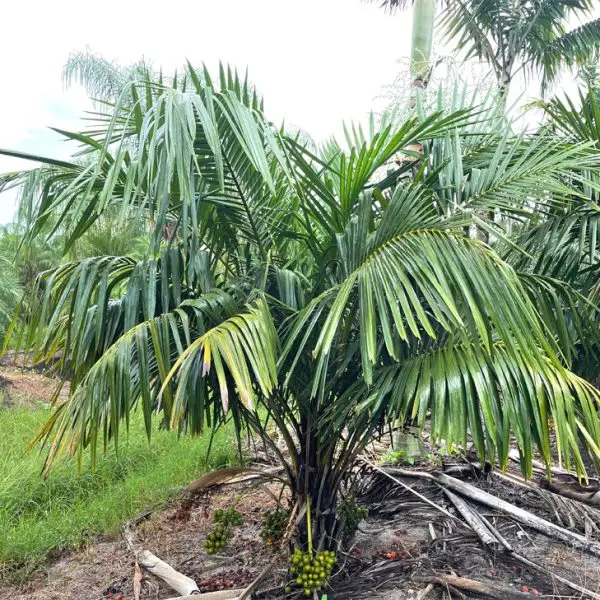
The Arikury Palm is a small and ornamental palm native to Brazil, recognized for its arching pinnate leaves and rough-textured trunk marked by persistent leaf bases. It generally grows up to 8 to 10 feet tall and is ideal for patio containers, small yards, or as an accent plant in tropical gardens.
This palm enjoys full sun to partial shade and requires well-drained soil with moderate moisture. It is fairly adaptable but benefits from protection during cold snaps. Regular watering and the occasional application of a slow-release fertilizer will keep it healthy and attractive throughout the growing season.
Syagrus schizophylla is hardy in USDA zones 9b–11. With its tidy growth and tropical appeal, the Arikury Palm is well-suited for both urban and coastal landscapes.
Macaw Palm (Acrocomia aculeata)

The Macaw Palm, also known as the Grugru Palm or Coyol Palm, is a tall, solitary-trunked palm native to Central and South America. It features large feather-like fronds and a trunk covered in long, sharp spines. This palm can reach heights of 50 to 60 feet and is known for producing edible fruit and oil-rich seeds.
It grows best in full sun and well-draining soil, with moderate water requirements. This hardy palm can withstand drought and high heat once established. Due to its spiny trunk, it should be planted in areas away from high-traffic zones to avoid accidental injury.
The Macaw Palm is suitable for USDA zones 9–11. It’s a striking choice for spacious tropical landscapes and is also valued for its potential in sustainable oil production.
Hyphaene Palm (Hyphaene thebaica)
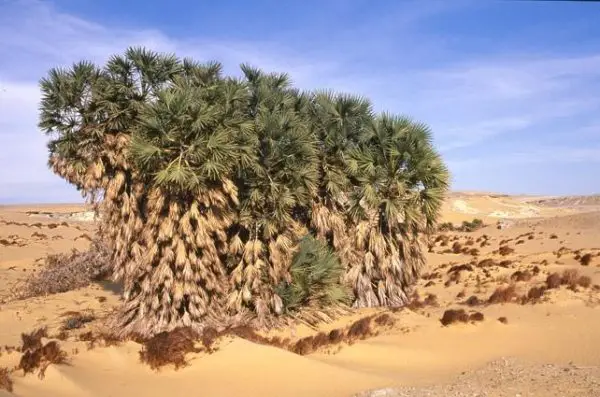
The Hyphaene Palm, commonly known as the Doum Palm or Gingerbread Palm, is native to northern and central Africa. This unique palm has a branching trunk—a rare trait among palms—and fan-shaped leaves. It can reach up to 50 feet in height and produces edible fruits often used in traditional African medicine and food.
It prefers full sun and sandy or loamy soil with good drainage. This drought-tolerant species thrives in arid to semi-arid conditions and requires minimal watering once established. It is slow-growing but highly durable in tough climates, making it a strong candidate for water-wise landscaping.
Hyphaene thebaica is hardy in USDA zones 10–11. It’s well-suited for desert gardens, coastal areas, or cultural and edible plant collections.
Tahina Palm (Tahina spectabilis)
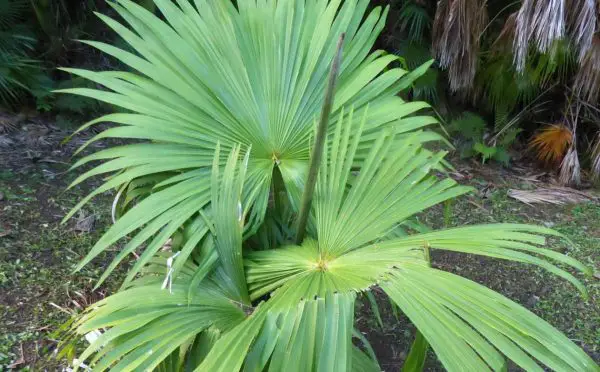
The Tahina Palm, or “Suicide Palm,” is an extremely rare and spectacular palm species endemic to Madagascar. This palm is monocarpic—it flowers once at maturity (after several decades), then dies. It grows up to 60 feet tall and produces massive, fan-shaped leaves and an enormous central flower spike.
This palm prefers full sun and thrives in sandy, well-drained soils. It needs consistent watering and high humidity, especially when young. Because of its rarity and slow growth, it is mainly found in botanical gardens or in private collections of palm enthusiasts.
Tahina spectabilis is hardy in USDA zones 10–11. It’s one of the most awe-inspiring palms available and a true prize for tropical plant collectors or conservation-oriented landscapes.
Sugar Palm (Arenga pinnata)

The Sugar Palm, also known as Arenga pinnata or the Gomuti Palm, is a tall and robust palm native to tropical Asia. It features feather-like fronds and a rough, fibrous trunk that can grow up to 60 feet tall. One of its most notable traits is the sweet sap extracted from its inflorescences, which is used to produce palm sugar.
This palm grows best in full sun to partial shade and prefers fertile, moist, and well-draining soils. It thrives in humid tropical environments and requires regular watering, particularly during dry spells. It’s a monocarpic species, meaning it flowers once and then dies, though it often produces offsets or suckers at its base.
Arenga pinnata is suitable for USDA zones 10–11. It’s commonly cultivated for its sugar and fiber in tropical agricultural systems but also serves as a striking ornamental specimen in large gardens or parks.
African Oil Palm (Elaeis guineensis)
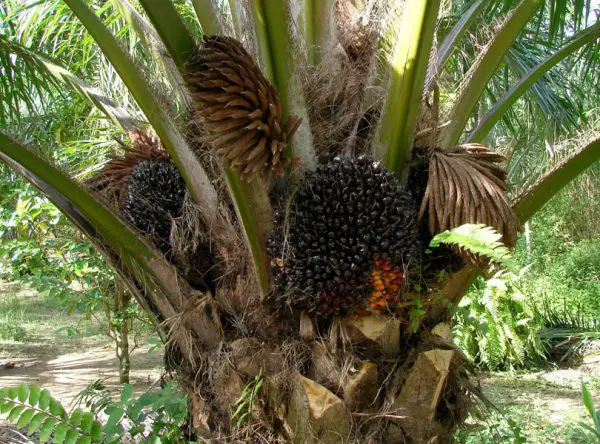
The African Oil Palm is an economically vital species native to West and Central Africa. It is widely cultivated for its high-yielding oil-rich fruits, used in cooking oils, cosmetics, and biofuels. The palm grows to about 20 to 30 feet tall and has long pinnate fronds that give it a lush, tropical look.
It prefers full sun and moist, loamy soil with good drainage. This palm requires ample water and warmth for optimal fruit production and is typically grown in tropical plantation settings. Regular fertilization enhances oil yields and overall plant health.
Elaeis guineensis thrives in USDA zones 10b–11. While it’s primarily grown for commercial purposes, it can be used ornamentally in tropical landscapes with plenty of space and heat.
Raffia Palm (Raphia farinifera)

The Raffia Palm is native to Madagascar and tropical parts of Africa and is known for having the largest leaves of any plant—reaching up to 80 feet long. It has a clumping growth habit and produces valuable raffia fibers, widely used in weaving and handicrafts.
This palm grows best in wet, marshy areas and thrives in full sun to partial shade. It requires consistently moist soil and high humidity to flourish, making it well-suited to rain gardens or water-adjacent landscapes. It is monocarpic but forms large clumps that continue to grow.
Raphia farinifera is hardy in USDA zones 10–11. It’s a unique and bold addition to tropical gardens or eco-landscapes where water is plentiful.
Talipot Palm (Corypha umbraculifera)
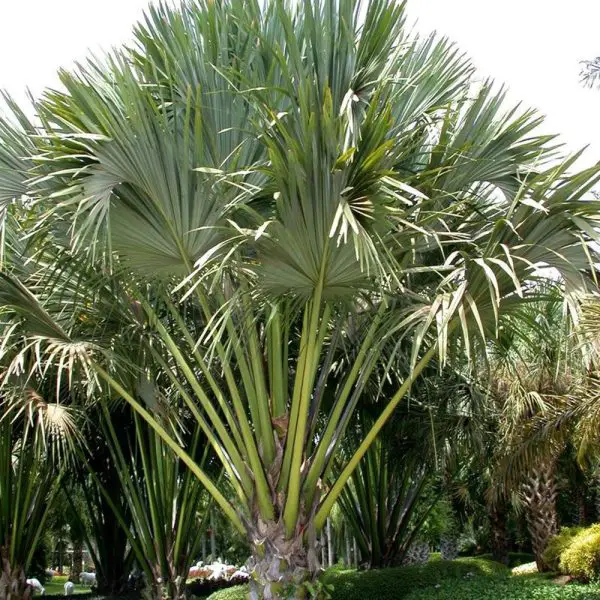
The Talipot Palm is one of the most majestic and largest palms in the world, native to southern India and Sri Lanka. It can grow up to 80–100 feet tall and is known for its massive fan-shaped leaves, each reaching up to 15 feet wide. This monocarpic species produces a single, spectacular flowering event with a giant flower stalk before dying.
It requires full sun and well-draining soil to thrive, along with consistent moisture and a tropical climate. Because of its massive size and long lifespan (it may take 30–80 years to flower), it’s best suited to expansive gardens or public spaces.
Corypha umbraculifera is best grown in USDA zones 10–11. It’s a show-stopping palm ideal for collectors or botanical gardens looking to showcase rare tropical specimens.
Doum Palm (Hyphaene petersiana)
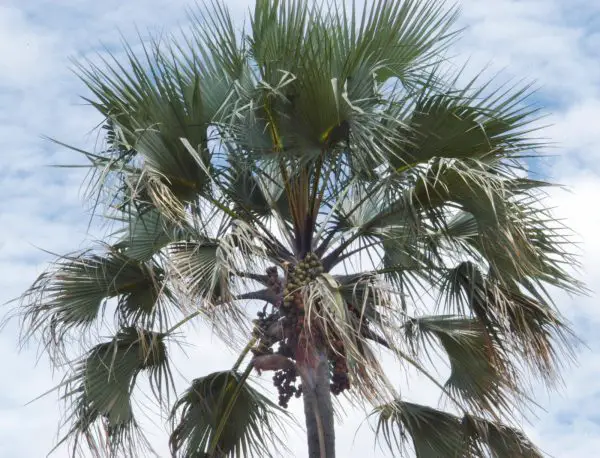
The Doum Palm, also known as Hyphaene petersiana, is native to eastern and southern Africa. Like other members of its genus, it has a rare branching trunk structure and large, fan-shaped leaves. It produces edible fruits often called “gingerbread fruits” due to their fibrous, sweet taste.
This palm thrives in full sun and sandy, well-drained soil and is highly drought-tolerant once established. It prefers warm, arid climates and can survive in marginal soils, making it a strong candidate for xeriscaping or desert-themed gardens.
Hyphaene petersiana is hardy in USDA zones 10–11. Its unique structure and practical fruit make it a standout in landscape design or ethnobotanical collections.
Livistona mariae
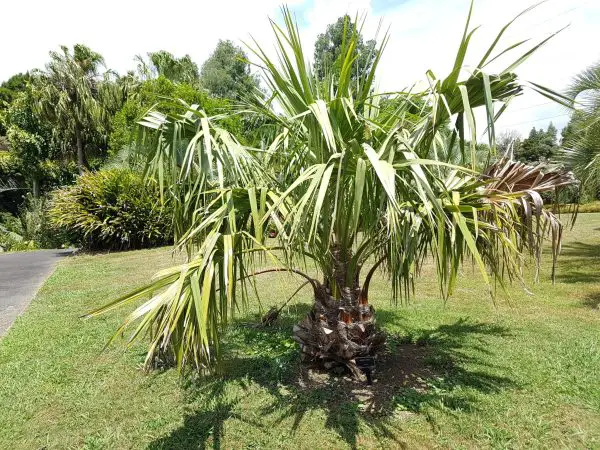
Livistona mariae, commonly known as the Central Australian Livistona or Red Cabbage Palm, is a rare and striking fan palm native to arid regions of Northern and Central Australia. It is noted for its bluish-green fan-shaped leaves with reddish or bronze undersides in young plants, giving it ornamental appeal. Mature trees can grow up to 50 feet tall with a tall, solitary trunk.
This palm prefers full sun and well-drained, sandy or loamy soil. Despite its native arid environment, it appreciates regular watering when grown in cultivation, especially during dry seasons. It is relatively low-maintenance and drought-tolerant once established, though it benefits from occasional feeding with a balanced fertilizer.
Livistona mariae grows well in USDA zones 9b–11. It’s a fantastic choice for xeriscaping, desert gardens, or tropical-style landscapes in warm, dry climates.
Calamus Palm (Calamus rotang)
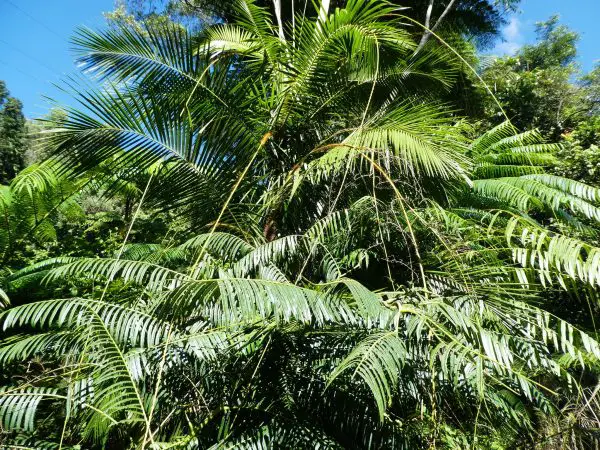
The Calamus Palm, or Calamus rotang, is a species of rattan palm known for its long, climbing stems and flexible canes, which are widely used in furniture and basket weaving. Native to Southeast Asia and India, it features slender, spiny stems and long pinnate leaves with hooked leaflets that help it climb through forest canopies.
This palm thrives in tropical rainforest conditions and prefers shaded to partially sunny locations with moist, rich soil. It requires high humidity and regular watering to simulate its natural jungle habitat. Because it can grow aggressively and spread via long, trailing stems, it’s best suited for large greenhouse collections or tropical garden settings.
Calamus rotang is suitable for USDA zones 11–12. While not commonly grown as an ornamental, it’s valued for its economic importance and can be a fascinating addition to specialized tropical gardens.
Salacca Palm (Salacca zalacca)
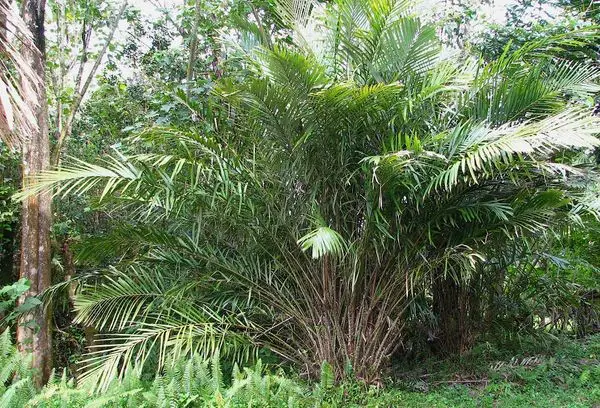
The Salacca Palm, also known as Salak or Snake Fruit Palm, is native to Indonesia and Malaysia. This short-statured, clustering palm is famous for its scaly-skinned fruit, which resembles snake skin and offers a sweet, acidic flavor. It grows in dense, low-growing thickets with spiny stems and leaf petioles.
Salacca zalacca prefers partial shade and thrives in wet, humid environments with rich, well-draining soil. It requires consistent watering and performs best when protected from strong winds. It’s commonly cultivated in Southeast Asia for its unique and popular fruit.
This palm is best suited to USDA zones 11–12. While not ideal for all climates, it can be grown in tropical gardens or greenhouses where warmth and humidity are maintained year-round.






